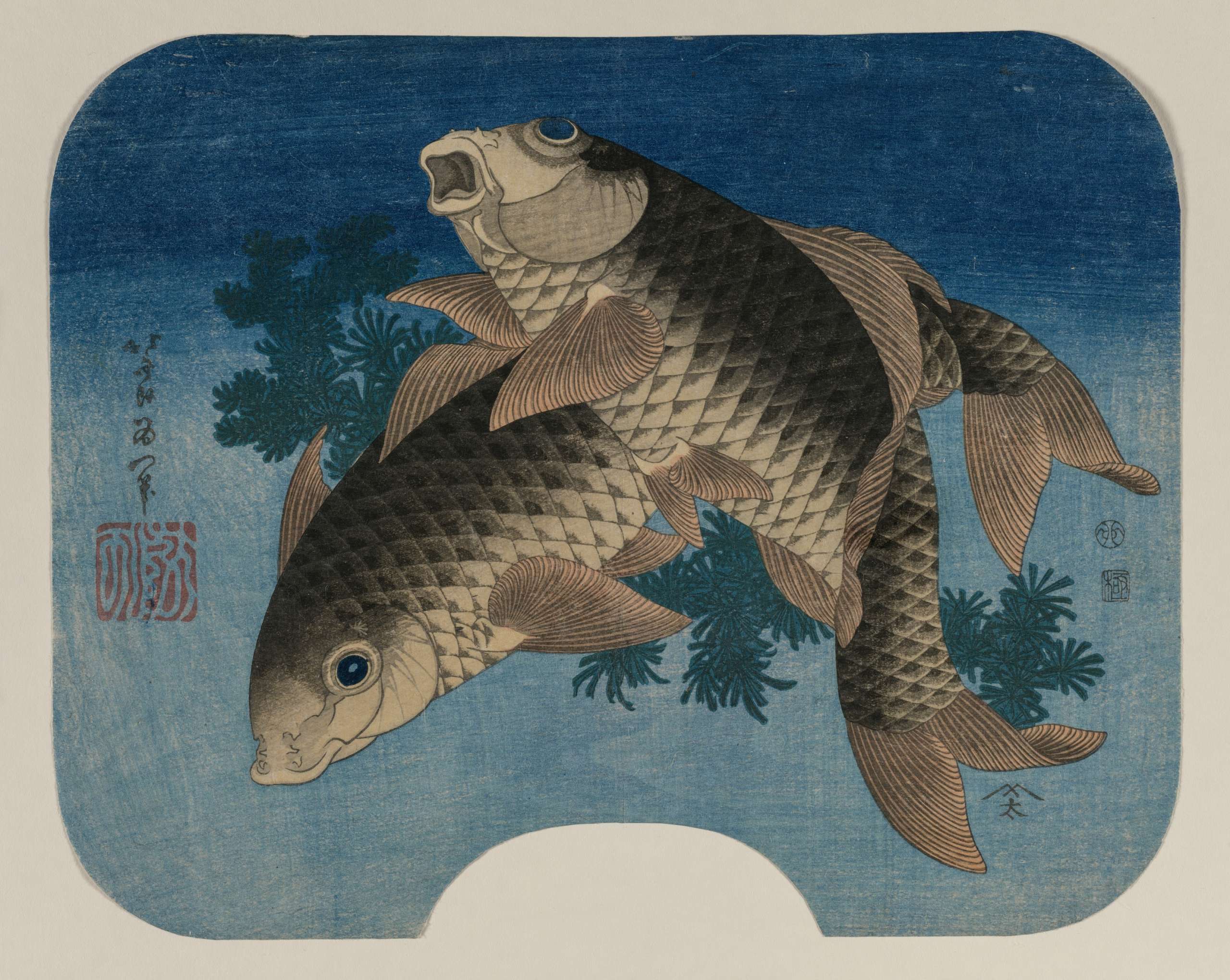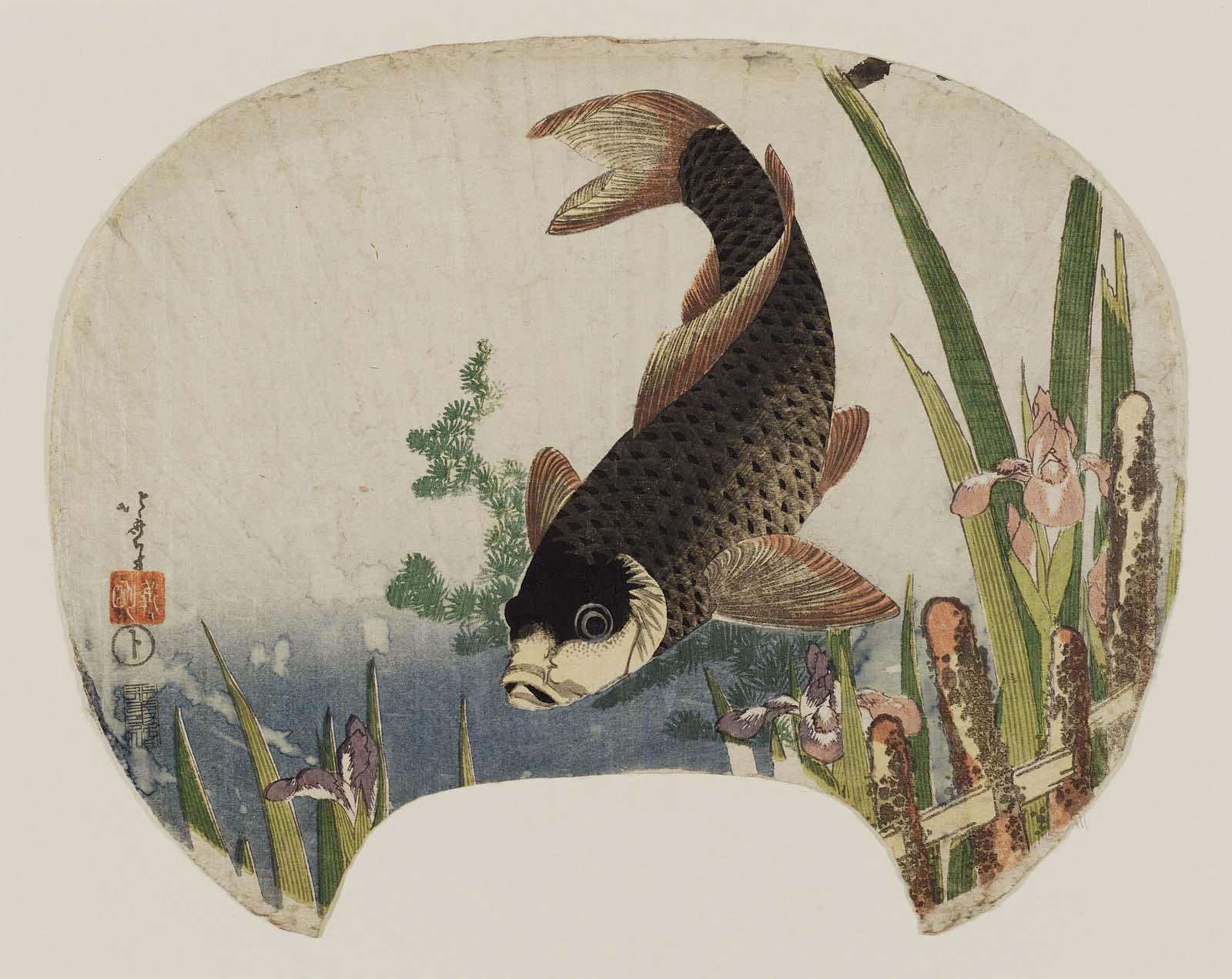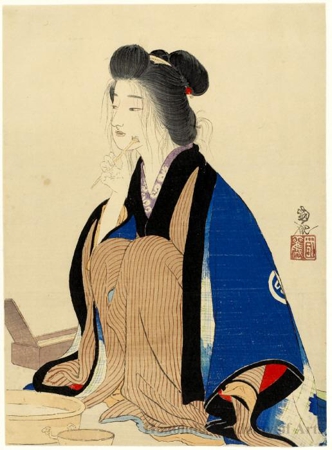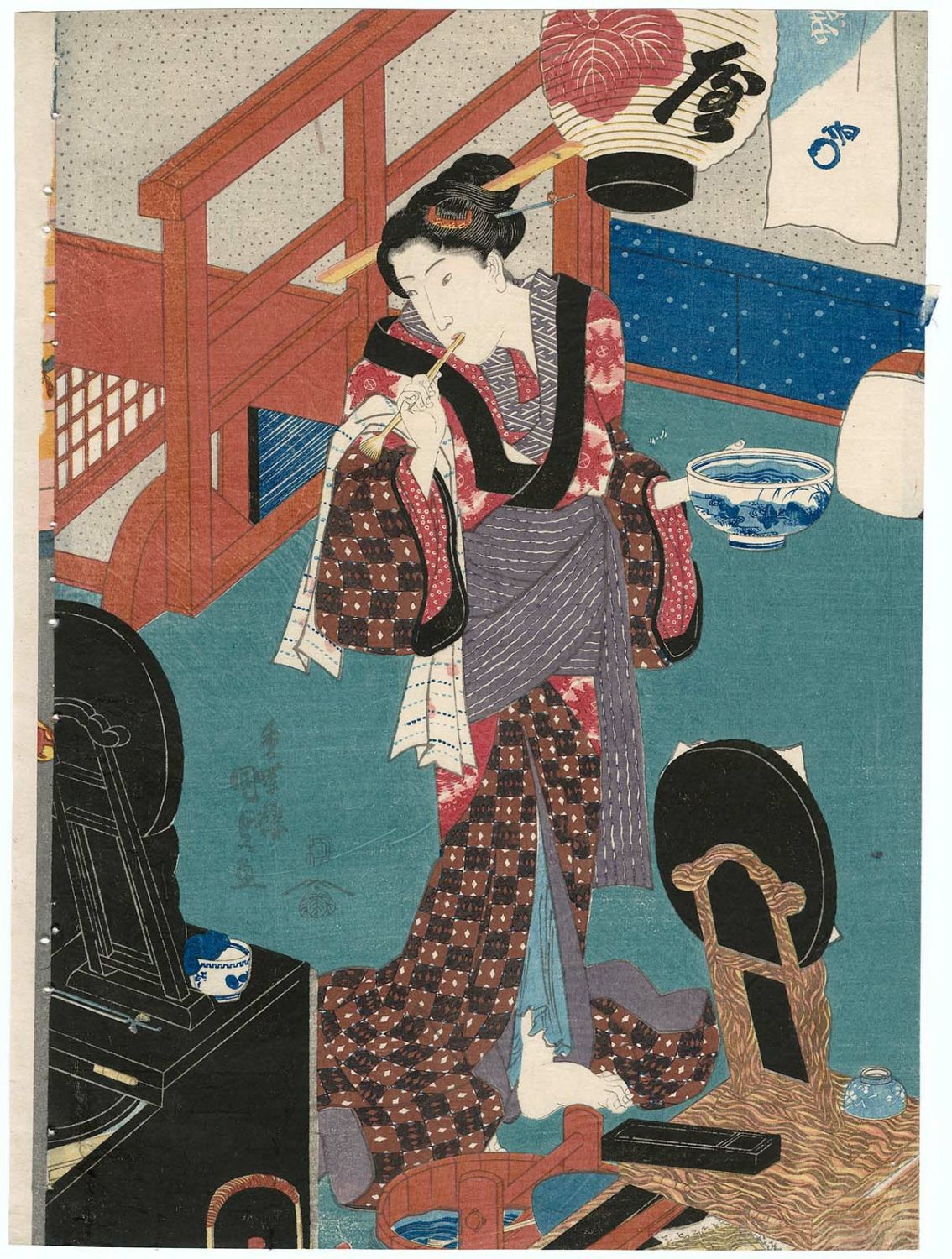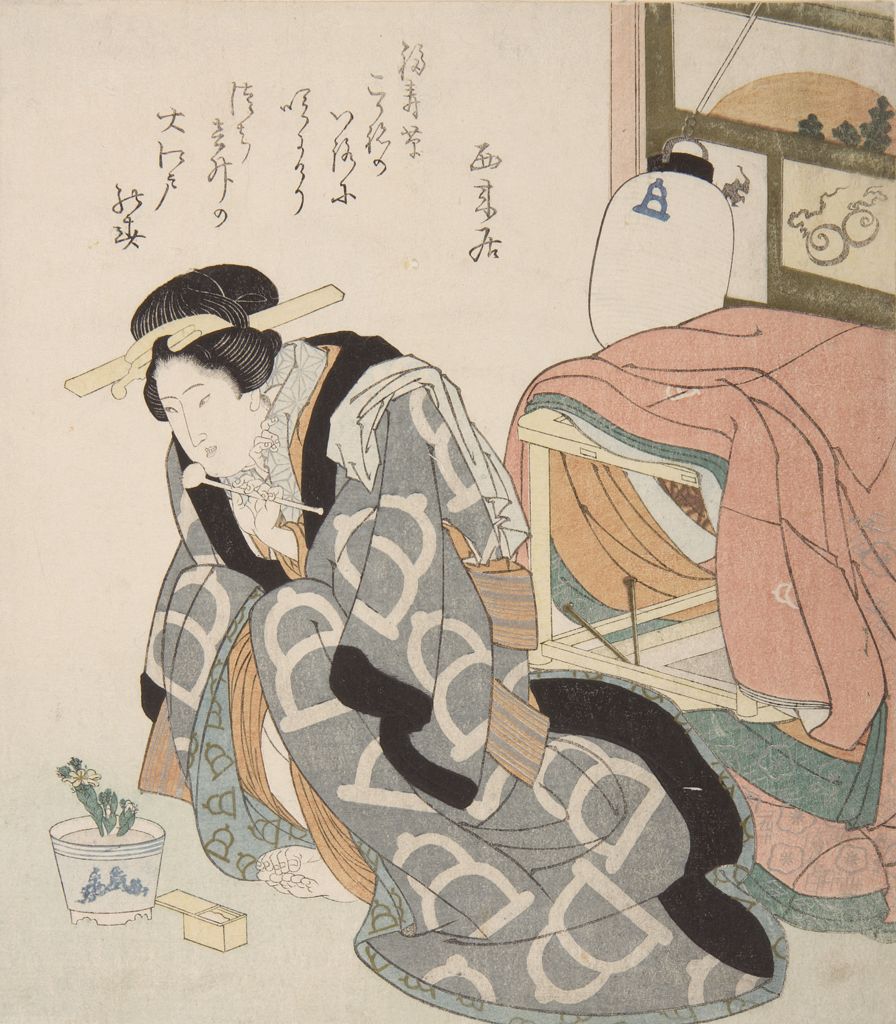-
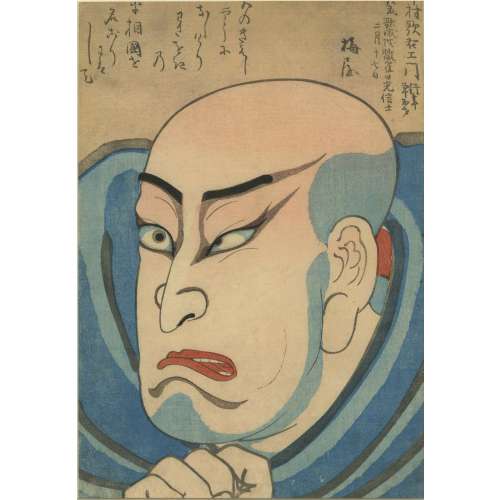 Utagawa Kuniyoshi (attributed to). Memorial portrait (Shini-e, death picture) of Nakamura Utaemon IV (a.k.a. Shikan II) as Taira no Kiyomori (1118-81). Date: 1852. Reference: [LIB-1030.2016] Robert Schaap. Heroes & ghosts: Japanese prints by Kuniyoshi, 1797-1861. — Leiden: Hotei Publishing, 1998; p. 165, image 176. [LIB-3316.2024] Chris Uhlenbeck, Jim Dwinger, Josephine Smit. The Riddles of Ukiyo-e: Women and Men in Japanese Prints. — Brussels: Ludion, 2023; pp. 242-3, № 119. Provenance: Herbert Egenolf Collection, Germany. Literature: Suzuki (1992) 317. Trimmed, unsigned.
Utagawa Kuniyoshi (attributed to). Memorial portrait (Shini-e, death picture) of Nakamura Utaemon IV (a.k.a. Shikan II) as Taira no Kiyomori (1118-81). Date: 1852. Reference: [LIB-1030.2016] Robert Schaap. Heroes & ghosts: Japanese prints by Kuniyoshi, 1797-1861. — Leiden: Hotei Publishing, 1998; p. 165, image 176. [LIB-3316.2024] Chris Uhlenbeck, Jim Dwinger, Josephine Smit. The Riddles of Ukiyo-e: Women and Men in Japanese Prints. — Brussels: Ludion, 2023; pp. 242-3, № 119. Provenance: Herbert Egenolf Collection, Germany. Literature: Suzuki (1992) 317. Trimmed, unsigned. -
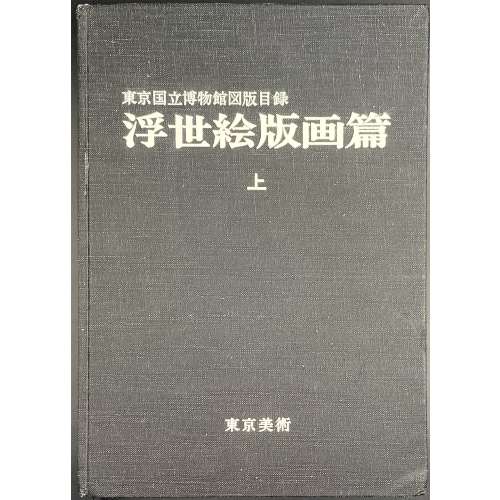 Title: Illustrated Catalogues of Tokyo National Museum: Ukiyo-e Prints [東京国立博物館図版目録 | 浮世絵版画編] (Tōkyō Kokuritsu Hakubutsukan zuhan mokuroku | Ukiyoe hanga hen); Publisher: Tokyo National Museum [東京国立博物館] (Tōkyō Kokuritsu Hakubutsukan). Three volumes, 26.3 x 18.7 cm, uniformly bound in black cloth with white characters to front cover and spine. Title-page: ILLUSTRATED CATALOGUES OF | TOKYO NATIONAL MUSEUM | UKIYO-E PRINTS | <1 (2, 3) > | 東京国立博物館図版目録 | 浮世絵版画編 | < 上 (中, 下) > || Volume 1 [上]: unpaginated 1 t.p., 2 colour plates, 1 contents, 70 (1-1354) – b/w plates, 1 + 48 paginated leaves (1-95 [96]) – text. Volume 2 [中]: unpaginated 1 t.p., 2 colour plates, 1 contents, 67 (1355-2493) – b/w plates + 33 paginated leaves (1-65 [66]) – text. Volume 3 [下]: unpaginated 1 t.p., 2 colour plates, 1 contents, 83 (2494-3926) – b/w plates + 35 paginated leaves (1-69 [70]) – text. Black and white photomechanical reproduction of almost four thousand woodblock prints with titles by the artist and in chronological order.
Title: Illustrated Catalogues of Tokyo National Museum: Ukiyo-e Prints [東京国立博物館図版目録 | 浮世絵版画編] (Tōkyō Kokuritsu Hakubutsukan zuhan mokuroku | Ukiyoe hanga hen); Publisher: Tokyo National Museum [東京国立博物館] (Tōkyō Kokuritsu Hakubutsukan). Three volumes, 26.3 x 18.7 cm, uniformly bound in black cloth with white characters to front cover and spine. Title-page: ILLUSTRATED CATALOGUES OF | TOKYO NATIONAL MUSEUM | UKIYO-E PRINTS | <1 (2, 3) > | 東京国立博物館図版目録 | 浮世絵版画編 | < 上 (中, 下) > || Volume 1 [上]: unpaginated 1 t.p., 2 colour plates, 1 contents, 70 (1-1354) – b/w plates, 1 + 48 paginated leaves (1-95 [96]) – text. Volume 2 [中]: unpaginated 1 t.p., 2 colour plates, 1 contents, 67 (1355-2493) – b/w plates + 33 paginated leaves (1-65 [66]) – text. Volume 3 [下]: unpaginated 1 t.p., 2 colour plates, 1 contents, 83 (2494-3926) – b/w plates + 35 paginated leaves (1-69 [70]) – text. Black and white photomechanical reproduction of almost four thousand woodblock prints with titles by the artist and in chronological order. -
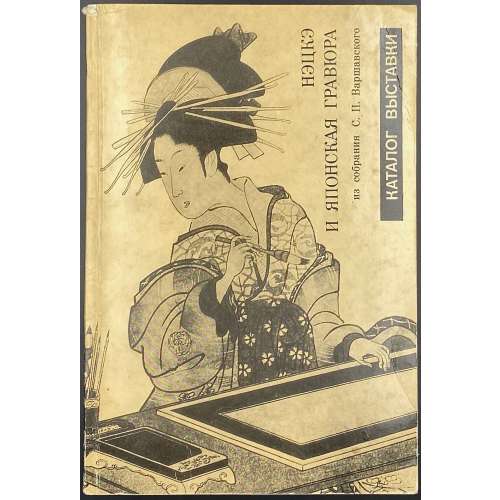 Mikhail Uspensky, Elena Varshavskaya. The netsuke and Japanese woodblock prints from the collection of S. P. Varshavsky. Printed by demand of The Hermitage Museum. Title-page (vertical bottom to top): ГОСУДАРСТВЕННЫЙ ОРДЕНА ЛЕНИНА | ЭРМИТАЖ | НЭЦКЭ | И ЯПОНСКАЯ | ГРАВЮРА | из собрания | С. П. Варшавского | КАТАЛОГ ВЫСТАВКИ | — | ЛЕНИНГРАД | “ИСКУССТВО” | ЛЕНИНГРАДСКОЕ ОТДЕЛЕНИЕ | 1983 | {vignette} || Description: Softcover, pictorial wrappers, 21.5 x 14.5 cm, pp.: [1-8] 9-42 [43-51] (b/w plates unpag.) [52] 53-76 [77-95] (b/w plates unpag.) [96] (colophon); total 96 pages plus four leaves of colour plates. Catalogue:137 entries of netsuke, 69 entries of Japanese woodblock prints. Print run: 3,000 copies. Contributors: Mikhail Uspensky [Михаил Владимирович Успенский] (Russian, 1953 – 1997) Elena Varshavsky [Елена Юрьевна Варшавская (Jewish-American, b. 1952) Vladislav Sisauri [Владислав Ираклиевич Сисаури] (Russian, b. 1944) Sergei Petrovich Varshavsky [Сергей Петрович Варшавский] (Jewish-Russian, 1906 – 1980).
Mikhail Uspensky, Elena Varshavskaya. The netsuke and Japanese woodblock prints from the collection of S. P. Varshavsky. Printed by demand of The Hermitage Museum. Title-page (vertical bottom to top): ГОСУДАРСТВЕННЫЙ ОРДЕНА ЛЕНИНА | ЭРМИТАЖ | НЭЦКЭ | И ЯПОНСКАЯ | ГРАВЮРА | из собрания | С. П. Варшавского | КАТАЛОГ ВЫСТАВКИ | — | ЛЕНИНГРАД | “ИСКУССТВО” | ЛЕНИНГРАДСКОЕ ОТДЕЛЕНИЕ | 1983 | {vignette} || Description: Softcover, pictorial wrappers, 21.5 x 14.5 cm, pp.: [1-8] 9-42 [43-51] (b/w plates unpag.) [52] 53-76 [77-95] (b/w plates unpag.) [96] (colophon); total 96 pages plus four leaves of colour plates. Catalogue:137 entries of netsuke, 69 entries of Japanese woodblock prints. Print run: 3,000 copies. Contributors: Mikhail Uspensky [Михаил Владимирович Успенский] (Russian, 1953 – 1997) Elena Varshavsky [Елена Юрьевна Варшавская (Jewish-American, b. 1952) Vladislav Sisauri [Владислав Ираклиевич Сисаури] (Russian, b. 1944) Sergei Petrovich Varshavsky [Сергей Петрович Варшавский] (Jewish-Russian, 1906 – 1980). -
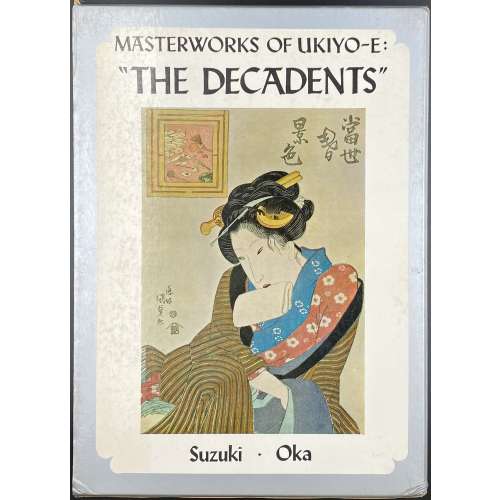 Description: Hardcover 26.5 x 19 cm, grey cloth, red lettering in kanji over black stripe to front, lettering to spine, tan endpapers, pictorial slipcase 27 x 19.5 cm; pp.: [1-6] 7-95 [96], pasted frontispiece and 79 colour illustrations with captions, within a collation. Series Masterworks of ukiyo-e, №8. ISBN: 9780870110986; 0870110985. Ref.: Worldcat Title-page (in frame): MASTERWORKS OF UKIYO-E | "THE DECADENTS” | by Jūzō Suzuki and Isaburō Oka | translation by John Bester | {publisher’s device} | KODANSHA INTERNATIONAL LTD. | Tokyo, Japan & Palo-Alto, Calif., U.S.A. || (Vertical text in kanji to the right, between rules). Artists: Utagawa Kunisada (Japanese [歌川 国貞], 1786 – 1865); Utagawa Kuniyoshi (Japanese [歌川 国芳], 1798 – 1861); Keisai Eisen [Japanese [渓斎 英泉], 1790 – 1848). Contributors: Jūzō Suzuki [鈴木重三] (Japanese, 1919 – 2010) – author. Isaburō Oka [岡畏三郎] (Japanese, 1914 –2010) – author. John Bester (British, 1927 – 2010) – translator Kunisada's fan print in this collection (exactly the same copy) [SVJP-0380.2022]:
Description: Hardcover 26.5 x 19 cm, grey cloth, red lettering in kanji over black stripe to front, lettering to spine, tan endpapers, pictorial slipcase 27 x 19.5 cm; pp.: [1-6] 7-95 [96], pasted frontispiece and 79 colour illustrations with captions, within a collation. Series Masterworks of ukiyo-e, №8. ISBN: 9780870110986; 0870110985. Ref.: Worldcat Title-page (in frame): MASTERWORKS OF UKIYO-E | "THE DECADENTS” | by Jūzō Suzuki and Isaburō Oka | translation by John Bester | {publisher’s device} | KODANSHA INTERNATIONAL LTD. | Tokyo, Japan & Palo-Alto, Calif., U.S.A. || (Vertical text in kanji to the right, between rules). Artists: Utagawa Kunisada (Japanese [歌川 国貞], 1786 – 1865); Utagawa Kuniyoshi (Japanese [歌川 国芳], 1798 – 1861); Keisai Eisen [Japanese [渓斎 英泉], 1790 – 1848). Contributors: Jūzō Suzuki [鈴木重三] (Japanese, 1919 – 2010) – author. Isaburō Oka [岡畏三郎] (Japanese, 1914 –2010) – author. John Bester (British, 1927 – 2010) – translator Kunisada's fan print in this collection (exactly the same copy) [SVJP-0380.2022]: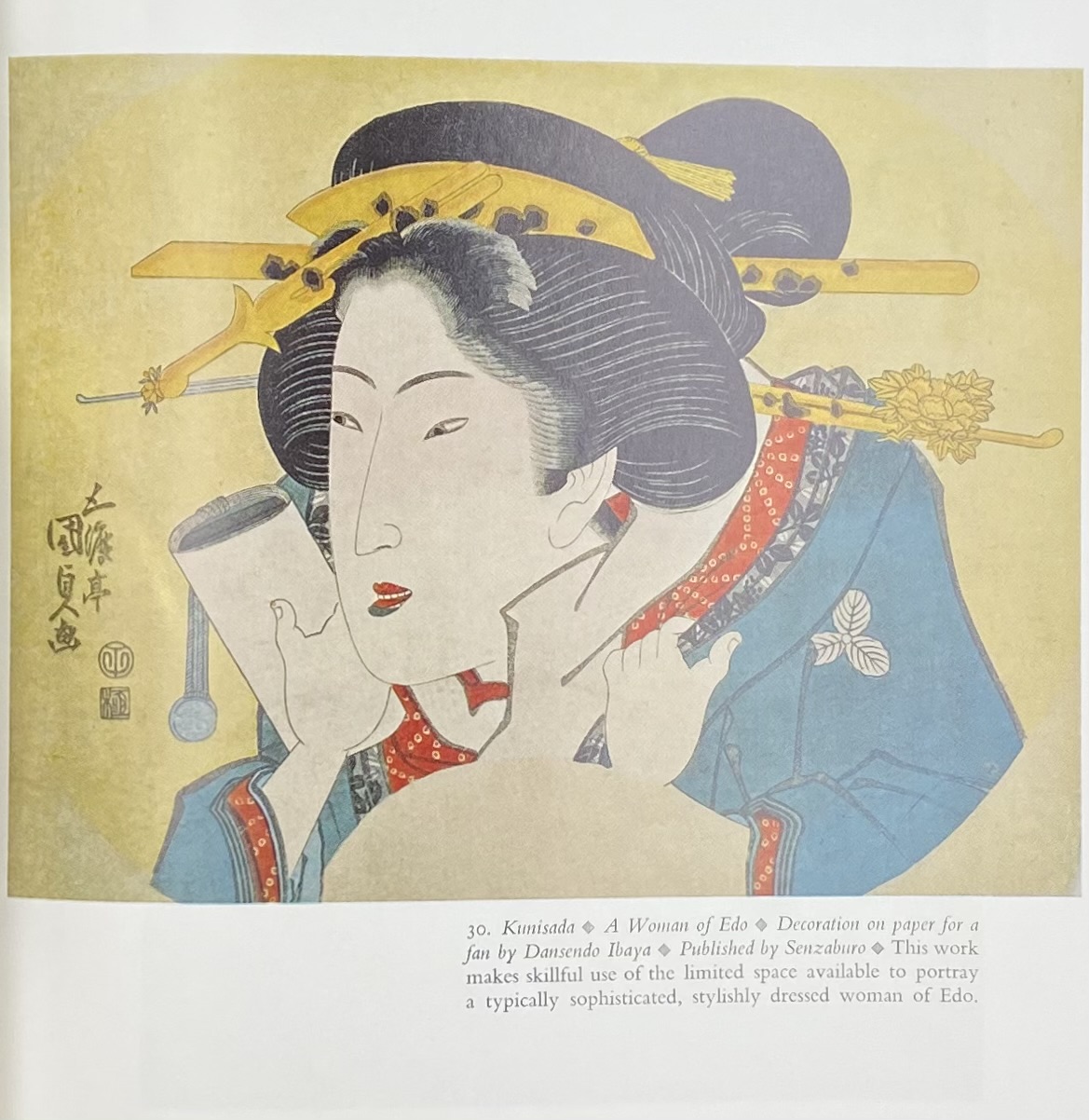
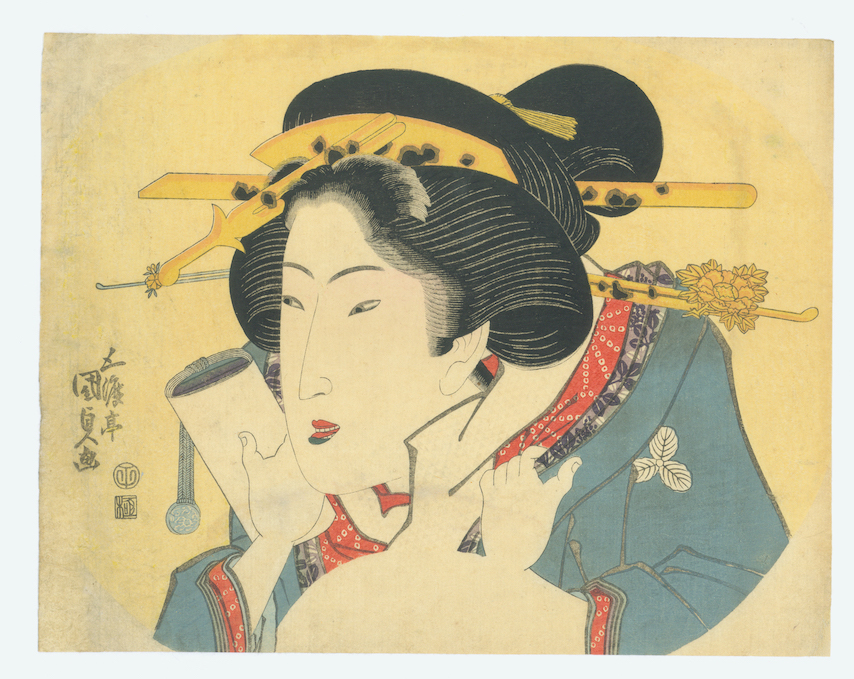
-
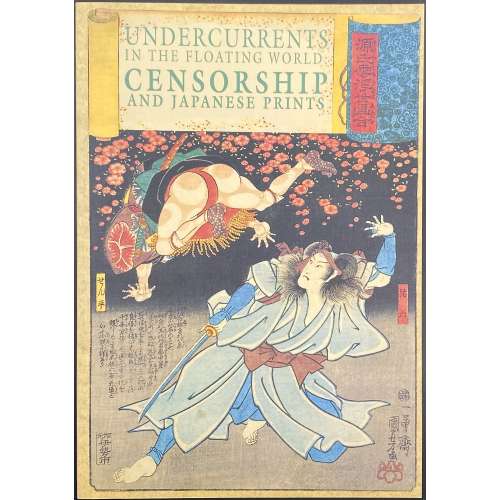 Paperback, 27.5 x 19 cm, pictorial wrappers, lettering to front wrapper and spine, pp.: [i-iv] v-viii, 1-104, ils.: 50 figures; catalogue, notes, and bibliography. Title-page: UNDERCURRENTS | IN THE FLOATING WORLD: | CENSORSHIP | AND JAPANESE PRINTS | Sarah E. Thompson | H. D. Harootunian | {kiwame seal} | THE ASIA SOCIETY GALLERIES | NEW YORK || Exhibition in NY: October 9, 1991 – January 5, 1992. Authors: Sarah E. Thompson (American, b. 1951) Harry D. Harootunian (Armenian-American, b. 1929)
Paperback, 27.5 x 19 cm, pictorial wrappers, lettering to front wrapper and spine, pp.: [i-iv] v-viii, 1-104, ils.: 50 figures; catalogue, notes, and bibliography. Title-page: UNDERCURRENTS | IN THE FLOATING WORLD: | CENSORSHIP | AND JAPANESE PRINTS | Sarah E. Thompson | H. D. Harootunian | {kiwame seal} | THE ASIA SOCIETY GALLERIES | NEW YORK || Exhibition in NY: October 9, 1991 – January 5, 1992. Authors: Sarah E. Thompson (American, b. 1951) Harry D. Harootunian (Armenian-American, b. 1929) -
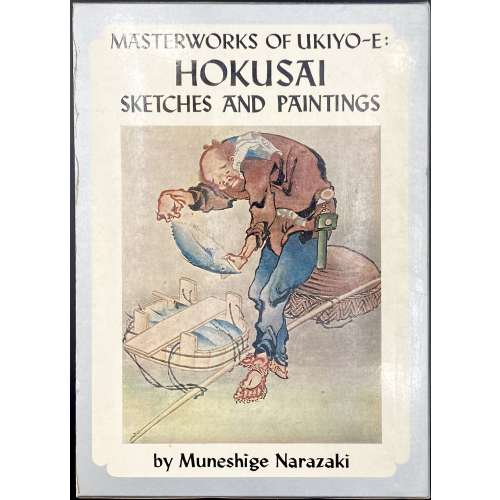 Hardcover volume from the series Masterworks of ukiyo-e, 26.1 x 19 cm, bound in canvas, red characters on black strip to front, red and black lettering to spine, tan embossed endpapers, in a pictorial slipcase with series design (black lettering on silver spine); pp: [1-6]: h.t./frontis. (colour plate pasted in), t.p./imprint, contents/acknowledgements), 7-16 text, 17-96 (79 plates w/captions). Title-page (in frame): MASTERWORKS OF UKIYO-E | HOKUSAI | SKETCHES AND PAINTINGS | by Muneshige Narazaki | English adaptation by John Bester | {publisher’s device} | KODANSHA INTERNATIONAL LTD. | Tokyo, Japan & Palo-Alto, Calif., U.S.A | {vertical, between rules 漫画肉筆画} || Series: Masterworks of ukiyo-e, № 7. Muneshige Narazaki [楢崎 宗重] (Japanese, 1904 – 2001) – author. Katsushika Hokusai [葛飾 北斎] (Japanese, 1760 – 1849) – artist. John Bester (British, 1927 – 2010) – adaptation.
Hardcover volume from the series Masterworks of ukiyo-e, 26.1 x 19 cm, bound in canvas, red characters on black strip to front, red and black lettering to spine, tan embossed endpapers, in a pictorial slipcase with series design (black lettering on silver spine); pp: [1-6]: h.t./frontis. (colour plate pasted in), t.p./imprint, contents/acknowledgements), 7-16 text, 17-96 (79 plates w/captions). Title-page (in frame): MASTERWORKS OF UKIYO-E | HOKUSAI | SKETCHES AND PAINTINGS | by Muneshige Narazaki | English adaptation by John Bester | {publisher’s device} | KODANSHA INTERNATIONAL LTD. | Tokyo, Japan & Palo-Alto, Calif., U.S.A | {vertical, between rules 漫画肉筆画} || Series: Masterworks of ukiyo-e, № 7. Muneshige Narazaki [楢崎 宗重] (Japanese, 1904 – 2001) – author. Katsushika Hokusai [葛飾 北斎] (Japanese, 1760 – 1849) – artist. John Bester (British, 1927 – 2010) – adaptation. -
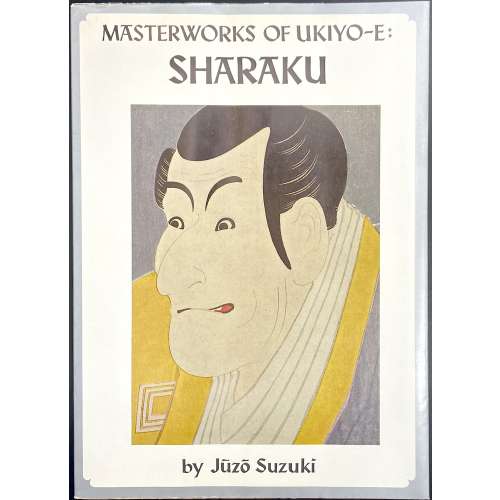 Paperback volume, 25.8 x 18.6 cm, brown embossed wrappers with framed Japanese characters along the outer margin, pictorial dust jacket with series design (black lettering and vignette in silver border to wrappers, black lettering on silver to spine); pp: [1-6]: h.t./frontis. (colour plate pasted in), t.p./imprint, contents/blank), 7-32 text, 33-96 (59 plates w/captions). Title-page (in frame): MASTERWORKS OF UKIYO-E | SHARAKU | by Jūzō Suzuki | Translated by John Bester | {publisher’s device} | KODANSHA INTERNATIONAL LTD. | Tokyo, Japan & Palo-Alto, Calif., U.S.A | {vertical between rules 写楽} || Series: Masterworks of ukiyo-e, № 2. Contributors: Jūzō Suzuki [鈴木 重三] (Japanese, 1919 – 2010) – author. John Bester (British, 1927 – 2010) – translator. Tōshūsai Sharaku [東洲斎 写楽] (Japanese, fl. 1794 – 1795) – artist.
Paperback volume, 25.8 x 18.6 cm, brown embossed wrappers with framed Japanese characters along the outer margin, pictorial dust jacket with series design (black lettering and vignette in silver border to wrappers, black lettering on silver to spine); pp: [1-6]: h.t./frontis. (colour plate pasted in), t.p./imprint, contents/blank), 7-32 text, 33-96 (59 plates w/captions). Title-page (in frame): MASTERWORKS OF UKIYO-E | SHARAKU | by Jūzō Suzuki | Translated by John Bester | {publisher’s device} | KODANSHA INTERNATIONAL LTD. | Tokyo, Japan & Palo-Alto, Calif., U.S.A | {vertical between rules 写楽} || Series: Masterworks of ukiyo-e, № 2. Contributors: Jūzō Suzuki [鈴木 重三] (Japanese, 1919 – 2010) – author. John Bester (British, 1927 – 2010) – translator. Tōshūsai Sharaku [東洲斎 写楽] (Japanese, fl. 1794 – 1795) – artist. -
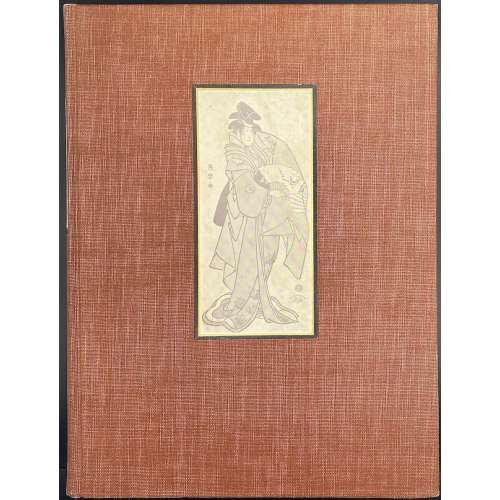 Hardcover volume, 31 x 23.5 cm, bound in full crimson canvas, reproduction colour print with black border pasted to embossed panel, ivory paper label with black lettering to spine, pp.: ffl, [1-4] (t.p./imprint, dedication/blank, 5-337 [338] colophon, 146 b/w woodblock prints by Sharaku photomechanically reproduced, within the pagination. Title-page: THE SURVIVING WORKS OF | SHARAKU | By HAROLD G. HENDERSON | and LOUIS V. LEDOUX | {device} | {blank} | PUBLISHED BY E. WEYNE • NEW YORK | ON BEHALF OF THE | SOCIETY OF THE JAPANESE STUDIES | 1939 || Colophon: PRINTED BY PETER BEILENSON AT THE WALPOLE PRINTING OFFICE | MOUNT VERNON • NEW YORK || Contributors: Harold Gould Henderson (American, 1889 – 1974)– author. Louis Vernon Ledoux (American, 1880 – 1948) – author. Tōshūsai Sharaku [東洲斎 写楽] (Japanese, fl. 1794 – 1795) – artist. Peter Beilenson (American, 1905 – 1962) – printer. Society for Japanese Studies – publisher. Walpole Printing Office (Mount Vernon, NY) – printer
Hardcover volume, 31 x 23.5 cm, bound in full crimson canvas, reproduction colour print with black border pasted to embossed panel, ivory paper label with black lettering to spine, pp.: ffl, [1-4] (t.p./imprint, dedication/blank, 5-337 [338] colophon, 146 b/w woodblock prints by Sharaku photomechanically reproduced, within the pagination. Title-page: THE SURVIVING WORKS OF | SHARAKU | By HAROLD G. HENDERSON | and LOUIS V. LEDOUX | {device} | {blank} | PUBLISHED BY E. WEYNE • NEW YORK | ON BEHALF OF THE | SOCIETY OF THE JAPANESE STUDIES | 1939 || Colophon: PRINTED BY PETER BEILENSON AT THE WALPOLE PRINTING OFFICE | MOUNT VERNON • NEW YORK || Contributors: Harold Gould Henderson (American, 1889 – 1974)– author. Louis Vernon Ledoux (American, 1880 – 1948) – author. Tōshūsai Sharaku [東洲斎 写楽] (Japanese, fl. 1794 – 1795) – artist. Peter Beilenson (American, 1905 – 1962) – printer. Society for Japanese Studies – publisher. Walpole Printing Office (Mount Vernon, NY) – printer -
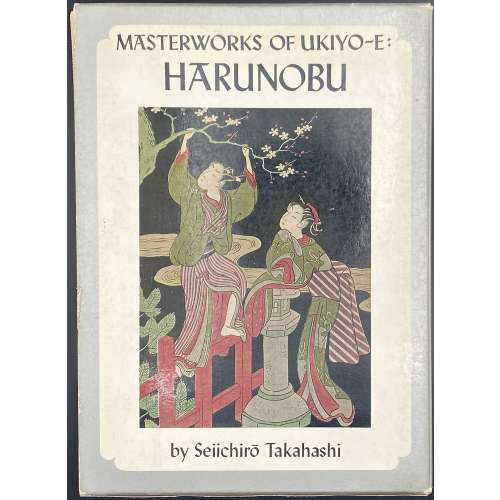 Hardcover volume from the series Masterworks of ukiyo-e, 26.5 x 19.1 cm, bound in unprimed canvas, red characters on black strip to front 春信, red and black lettering to spine, cream embossed endpapers, in a pictorial slipcase with series design (black lettering on silver spine); pp: [1-6]: h.t./frontis. (colour plate pasted in), t.p./imprint, contents/blank), 7-30 text, [2] faux-title, 33-96 (66 colour plates w/captions). Title-page (in frame): MASTERWORKS OF UKIYO-E | HARUNOBU | by Seiichirō Takahashi | English adaptation by John Bester | {publisher’s device} | KODANSHA INTERNATIONAL LTD. | Tokyo, Japan & Palo-Alto, Calif., U.S.A | {vertical, between rules 春信} || Series: Masterworks of ukiyo-e, № 6. Contributors: Seiichirō Takahashi [高橋誠一郎] (Japanese, 1884 – 1982) – author. Suzuki Harunobu [鈴木 春信] (Japanese, 1725 – 1770) – artist. John Bester (British, 1927 – 2010) – adaptation.
Hardcover volume from the series Masterworks of ukiyo-e, 26.5 x 19.1 cm, bound in unprimed canvas, red characters on black strip to front 春信, red and black lettering to spine, cream embossed endpapers, in a pictorial slipcase with series design (black lettering on silver spine); pp: [1-6]: h.t./frontis. (colour plate pasted in), t.p./imprint, contents/blank), 7-30 text, [2] faux-title, 33-96 (66 colour plates w/captions). Title-page (in frame): MASTERWORKS OF UKIYO-E | HARUNOBU | by Seiichirō Takahashi | English adaptation by John Bester | {publisher’s device} | KODANSHA INTERNATIONAL LTD. | Tokyo, Japan & Palo-Alto, Calif., U.S.A | {vertical, between rules 春信} || Series: Masterworks of ukiyo-e, № 6. Contributors: Seiichirō Takahashi [高橋誠一郎] (Japanese, 1884 – 1982) – author. Suzuki Harunobu [鈴木 春信] (Japanese, 1725 – 1770) – artist. John Bester (British, 1927 – 2010) – adaptation. -
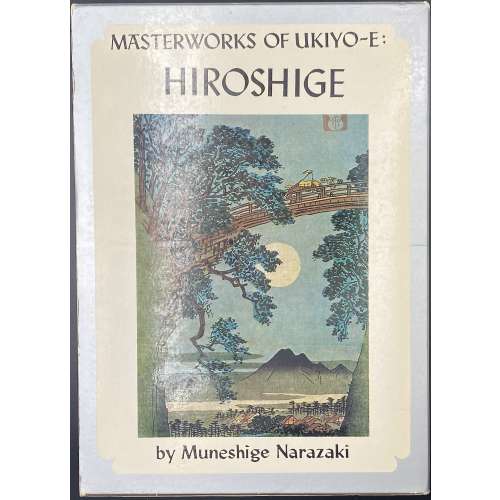 Hardcover volume from the series Masterworks of ukiyo-e, 26.3 x 19 cm, bound in unprimed canvas, red characters on black strip to front, red and black lettering to spine, tan flat endpapers, in a pictorial slipcase with series design (black lettering on silver spine); pp: [1-6]: h.t./frontis. (colour plate pasted in), t.p./imprint, contents/acknowledgements), 7-67 text, 27-30 map, 31-32 f.t./blank, 33-96 (65 plates w/captions). Title-page (in frame): MASTERWORKS OF UKIYO-E | HIROSHIGE | FAMOUS VIEWS | by Muneshige Narazaki | English adaptation by Richard L. Gage | {publisher’s device} | KODANSHA INTERNATIONAL LTD. | Tokyo, Japan & Palo-Alto, Calif., U.S.A | {vertical, between rules in ms 広重]} || Series: Masterworks of ukiyo-e, № 5. Edition: 1st edition ©1968, 2nd printing 1970. Muneshige Narazaki [楢崎 宗重] (Japanese, 1904 – 2001) – author. Utagawa Hiroshige [歌川 広重] a.k.a. Andō Hiroshige [安藤 広重] (Japanese, 1797 – 1858) – artist. Richard L. Gage (American, b. 1934) – adaptation.
Hardcover volume from the series Masterworks of ukiyo-e, 26.3 x 19 cm, bound in unprimed canvas, red characters on black strip to front, red and black lettering to spine, tan flat endpapers, in a pictorial slipcase with series design (black lettering on silver spine); pp: [1-6]: h.t./frontis. (colour plate pasted in), t.p./imprint, contents/acknowledgements), 7-67 text, 27-30 map, 31-32 f.t./blank, 33-96 (65 plates w/captions). Title-page (in frame): MASTERWORKS OF UKIYO-E | HIROSHIGE | FAMOUS VIEWS | by Muneshige Narazaki | English adaptation by Richard L. Gage | {publisher’s device} | KODANSHA INTERNATIONAL LTD. | Tokyo, Japan & Palo-Alto, Calif., U.S.A | {vertical, between rules in ms 広重]} || Series: Masterworks of ukiyo-e, № 5. Edition: 1st edition ©1968, 2nd printing 1970. Muneshige Narazaki [楢崎 宗重] (Japanese, 1904 – 2001) – author. Utagawa Hiroshige [歌川 広重] a.k.a. Andō Hiroshige [安藤 広重] (Japanese, 1797 – 1858) – artist. Richard L. Gage (American, b. 1934) – adaptation. -
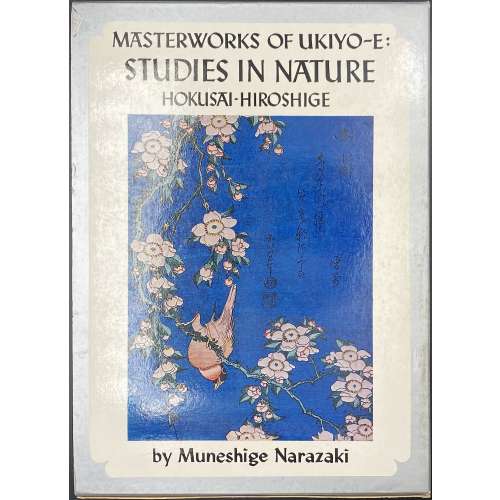 Hardcover volume from the series Masterworks of ukiyo-e, 26.3 x 19.2 cm, bound in unprimed canvas, red characters on black strip to front, red and black lettering to spine, tan flat endpapers, in a pictorial slipcase with series design (black lettering on silver spine); pp: [1-6]: h.t./frontis. (colour plate pasted in), t.p./imprint, contents/acknowledgements), 7-31 text, [32] blank, 33-96 (58 plates w/captions). Title-page (in frame): MASTERWORKS OF UKIYO-E | STUDIES IN NATURE | HOKUSAI-HIROSHIGE | by Muneshige Narazaki | Translated by John Bester | {publisher’s device} | KODANSHA INTERNATIONAL LTD. | Tokyo, Japan & Palo-Alto, Calif., U.S.A | {vertical, between rules 花鳥風月} || 花鳥風月 (Kachou Fugetsu) – beauties of nature. Series: Masterworks of ukiyo-e, № 11. Contributors: Muneshige Narazaki [楢崎 宗重] (Japanese, 1904 – 2001) – author. John Bester (British, 1927 – 2010) – translator. Katsushika Hokusai [葛飾 北斎] (Japanese, 1760 – 1849) – artist. Utagawa Hiroshige [歌川 広重] a.k.a. Andō Hiroshige [安藤 広重] (Japanese, 1797 – 1858) – artist.
Hardcover volume from the series Masterworks of ukiyo-e, 26.3 x 19.2 cm, bound in unprimed canvas, red characters on black strip to front, red and black lettering to spine, tan flat endpapers, in a pictorial slipcase with series design (black lettering on silver spine); pp: [1-6]: h.t./frontis. (colour plate pasted in), t.p./imprint, contents/acknowledgements), 7-31 text, [32] blank, 33-96 (58 plates w/captions). Title-page (in frame): MASTERWORKS OF UKIYO-E | STUDIES IN NATURE | HOKUSAI-HIROSHIGE | by Muneshige Narazaki | Translated by John Bester | {publisher’s device} | KODANSHA INTERNATIONAL LTD. | Tokyo, Japan & Palo-Alto, Calif., U.S.A | {vertical, between rules 花鳥風月} || 花鳥風月 (Kachou Fugetsu) – beauties of nature. Series: Masterworks of ukiyo-e, № 11. Contributors: Muneshige Narazaki [楢崎 宗重] (Japanese, 1904 – 2001) – author. John Bester (British, 1927 – 2010) – translator. Katsushika Hokusai [葛飾 北斎] (Japanese, 1760 – 1849) – artist. Utagawa Hiroshige [歌川 広重] a.k.a. Andō Hiroshige [安藤 広重] (Japanese, 1797 – 1858) – artist. -
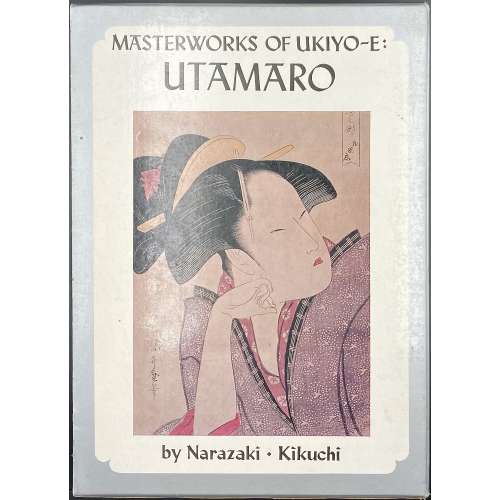 Hardcover volume from the series Masterworks of ukiyo-e, 26.5 x 19 cm, bound in unprimed canvas, red ms characters on black strip to front, red and black lettering to spine, tan embossed endpapers, in a pictorial slipcase with series design (black lettering on silver spine); pp: [1-6]: h.t./frontis. (colour plate pasted in), t.p./imprint, contents/acknowledgements), 7-31 text, [32] blank, 33-96 (76 plates w/captions). Title-page (in frame): MASTERWORKS OF UKIYO-E | UTAMARO | by Muneshige Narazaki and Sadao Kikuchi | Translated by John Bester | {publisher’s device} | KODANSHA INTERNATIONAL LTD. | Tokyo, Japan & Palo-Alto, Calif., U.S.A | {vertical, between rules 歌麿} || Series: Masterworks of ukiyo-e, № 4. Contributors: Muneshige Narazaki [楢崎 宗重] (Japanese, 1904 – 2001) – author. Sadao Kikuchi [菊地 貞雄] (Japanese, 1924 – 2017) – author. John Bester (British, 1927 – 2010) – translator. Kitagawa Utamaro [喜多川 歌麿] (Japanese, c. 1753 – 1806) – artist.
Hardcover volume from the series Masterworks of ukiyo-e, 26.5 x 19 cm, bound in unprimed canvas, red ms characters on black strip to front, red and black lettering to spine, tan embossed endpapers, in a pictorial slipcase with series design (black lettering on silver spine); pp: [1-6]: h.t./frontis. (colour plate pasted in), t.p./imprint, contents/acknowledgements), 7-31 text, [32] blank, 33-96 (76 plates w/captions). Title-page (in frame): MASTERWORKS OF UKIYO-E | UTAMARO | by Muneshige Narazaki and Sadao Kikuchi | Translated by John Bester | {publisher’s device} | KODANSHA INTERNATIONAL LTD. | Tokyo, Japan & Palo-Alto, Calif., U.S.A | {vertical, between rules 歌麿} || Series: Masterworks of ukiyo-e, № 4. Contributors: Muneshige Narazaki [楢崎 宗重] (Japanese, 1904 – 2001) – author. Sadao Kikuchi [菊地 貞雄] (Japanese, 1924 – 2017) – author. John Bester (British, 1927 – 2010) – translator. Kitagawa Utamaro [喜多川 歌麿] (Japanese, c. 1753 – 1806) – artist. -
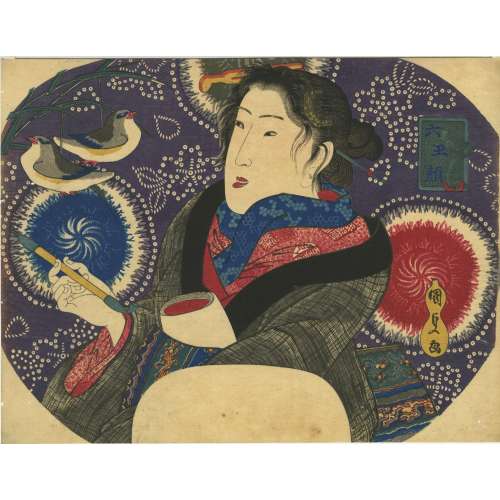 Artist: Utagawa Kunisada [歌川 国貞], a.k.a. Utagawa Toyokuni III [三代 歌川 豊国] (Japanese, 1786 – 1865). Signed: Toyokuni ga [豊国 画] in a yellow double-gourd cartouche. Publisher unknown (privately printed?) Media: Rigid fan print (Aiban Yoko-e Uchiwa-e, 合判横絵 団扇絵), 228 x 298 mm. Series title: Six Jewel Faces (六玉颜, mu tama-gao), a pun on Six Jewel Rivers (六玉河, Mu Tamagawa). The date seal and censor seal are absent. Another print from the same series in the Metropolitan Museum of New York reads:
Artist: Utagawa Kunisada [歌川 国貞], a.k.a. Utagawa Toyokuni III [三代 歌川 豊国] (Japanese, 1786 – 1865). Signed: Toyokuni ga [豊国 画] in a yellow double-gourd cartouche. Publisher unknown (privately printed?) Media: Rigid fan print (Aiban Yoko-e Uchiwa-e, 合判横絵 団扇絵), 228 x 298 mm. Series title: Six Jewel Faces (六玉颜, mu tama-gao), a pun on Six Jewel Rivers (六玉河, Mu Tamagawa). The date seal and censor seal are absent. Another print from the same series in the Metropolitan Museum of New York reads:The colorful background, with explosions of tie-dyed floral motifs, is a reminder of how Kunisada made all his thousands of Genji-print designs a visual record of different textile patterns of the day. The title Six Jewel Faces (Mu tama-gao), along with its allusion to the literary theme of Six Jewel Rivers, suggests that this set of fan prints captures the appearance of a half-dozen attractive individuals, and, indeed, the other five works in the set show images of beautiful women, mostly courtesans of the pleasure quarters.
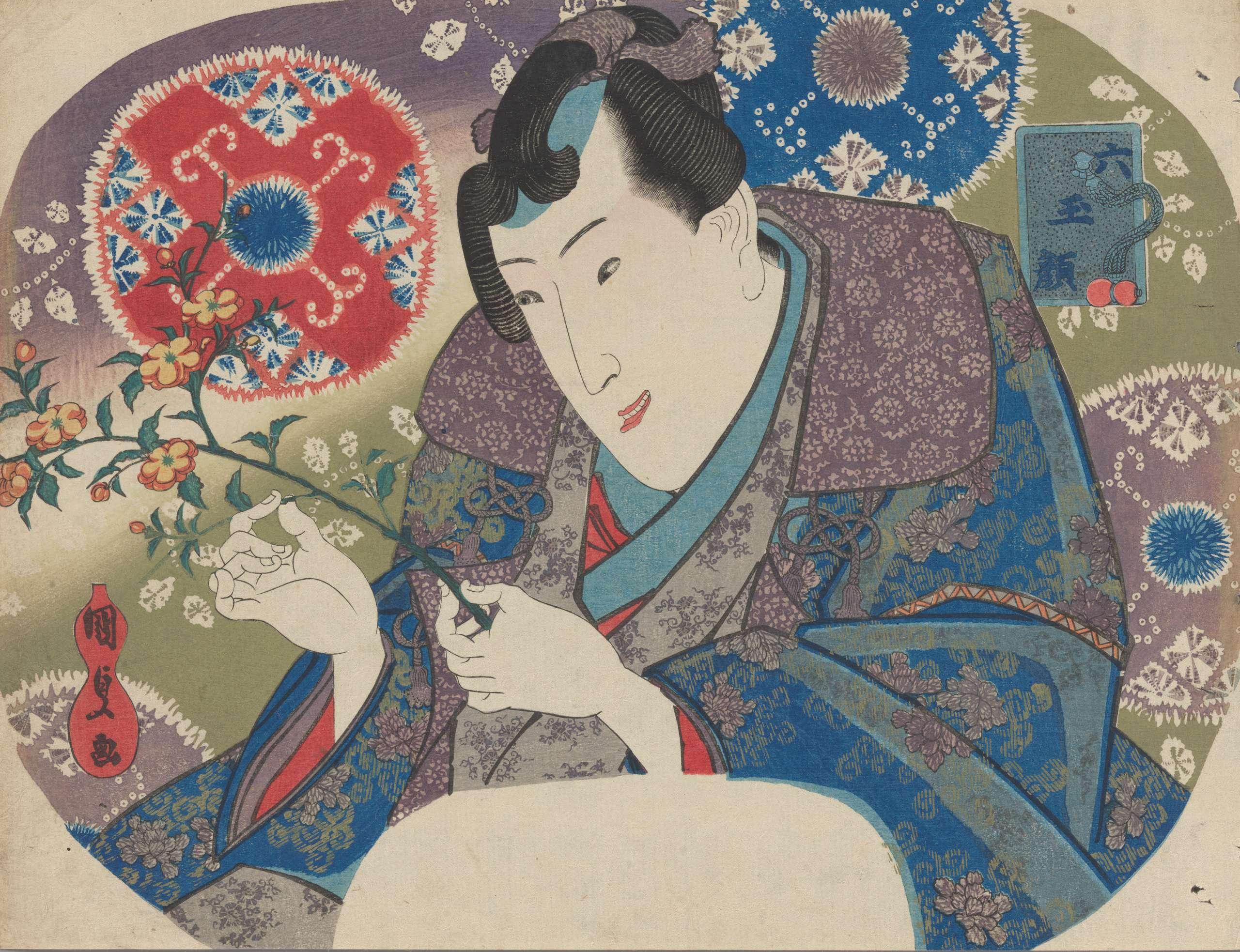 Mitsuuji with Mountain Roses (Yamabuki), from the series “Six Jewel Faces” (Mu tama-gao).
MET Accession Number:2019.3
References:
1) [LIB-2967.2022] Utagawa Kunisada: His world revisited / Catalogue 17, Exhibition March 17-21, 2021. — NY: Sebastian Izzard, LLC., 2021.
2) [LIB-3428.2025] Christie’s, New York: Japanese Prints, Paintings, and Screens, Monday, 24 November 1997 / Sales Catalogue, №№ 84-89.
Description by the latter: "aiban uchiwa-e (22.7 × 29.8 cm.); a beauty against a background of tie-dyed fabric patterns holding a pipe looking at toy birds hanging from bamboo, from the series Mutamagao “Six jewel faces”, the bird decorations alluding to the Jewel River in Noda (Chidori no Tamagawa) in Rikuzen province, signed Kunisada ga".
Mitsuuji with Mountain Roses (Yamabuki), from the series “Six Jewel Faces” (Mu tama-gao).
MET Accession Number:2019.3
References:
1) [LIB-2967.2022] Utagawa Kunisada: His world revisited / Catalogue 17, Exhibition March 17-21, 2021. — NY: Sebastian Izzard, LLC., 2021.
2) [LIB-3428.2025] Christie’s, New York: Japanese Prints, Paintings, and Screens, Monday, 24 November 1997 / Sales Catalogue, №№ 84-89.
Description by the latter: "aiban uchiwa-e (22.7 × 29.8 cm.); a beauty against a background of tie-dyed fabric patterns holding a pipe looking at toy birds hanging from bamboo, from the series Mutamagao “Six jewel faces”, the bird decorations alluding to the Jewel River in Noda (Chidori no Tamagawa) in Rikuzen province, signed Kunisada ga".
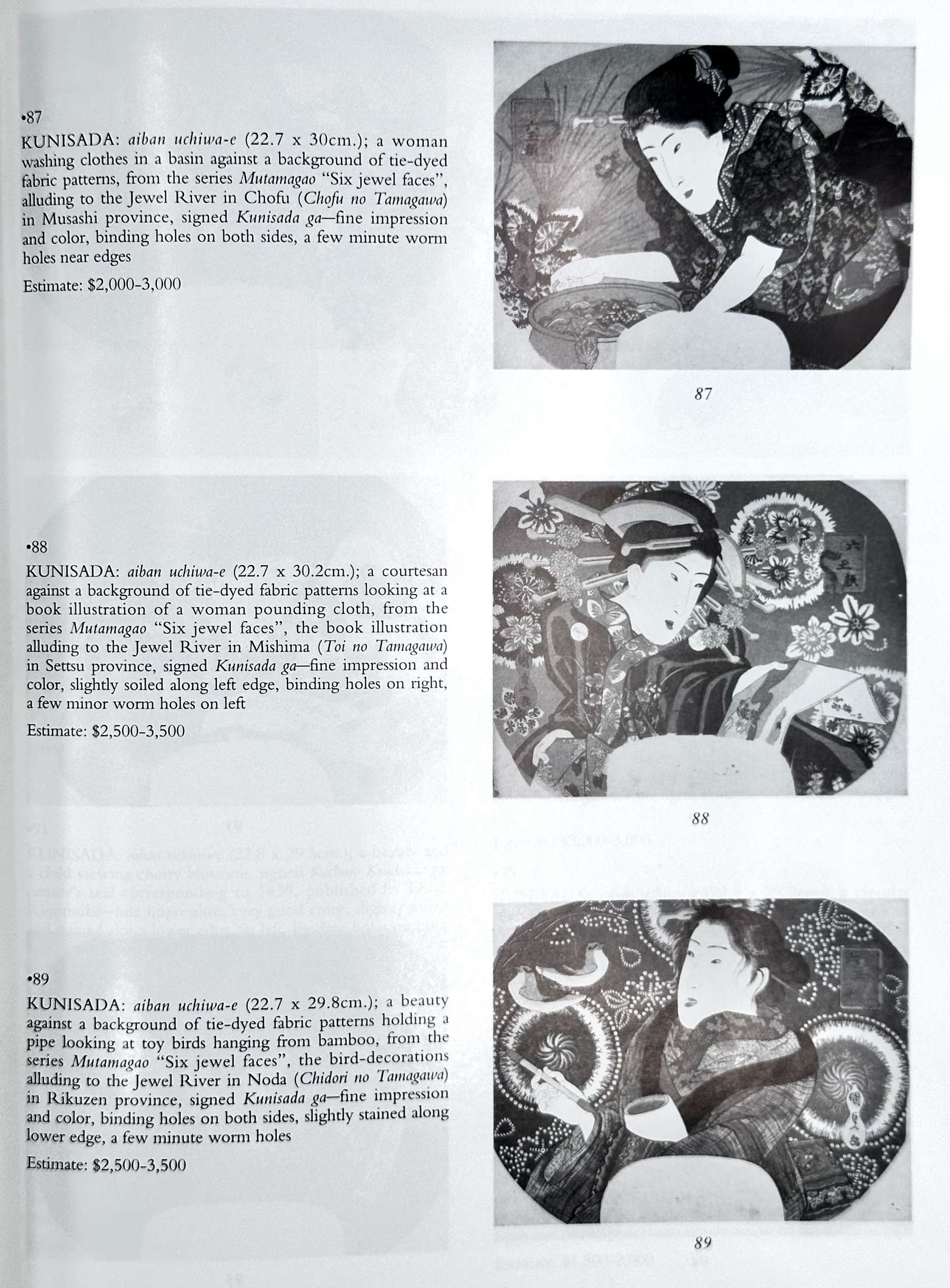

-
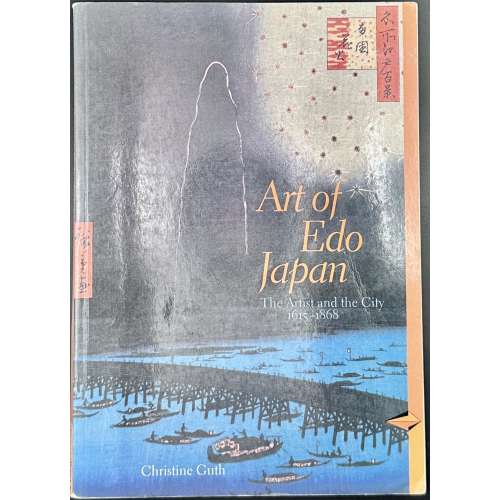 Softcover, pictorial wrappers, 235 x 165 mm, pp. [1-9] 10-176, 120 illustrations, incl. 109 in full colour, 3 maps, glossary, and timeline. An enveloped postcard to E. Varshavsky laid in. Text profusely marked with coloured highlighters. Title-page (pictorial): Art of Edo Japan | The Artist and the City 1615-1868 | Christine Guth | PERSPECTIVES | HARRY N. ABRAMS, INC. PUBLISHERS || Contents: NOTE TO THE READER Map: Japan during the Edo period INTRODUCTION: Mapping the Artistic Landscape
Softcover, pictorial wrappers, 235 x 165 mm, pp. [1-9] 10-176, 120 illustrations, incl. 109 in full colour, 3 maps, glossary, and timeline. An enveloped postcard to E. Varshavsky laid in. Text profusely marked with coloured highlighters. Title-page (pictorial): Art of Edo Japan | The Artist and the City 1615-1868 | Christine Guth | PERSPECTIVES | HARRY N. ABRAMS, INC. PUBLISHERS || Contents: NOTE TO THE READER Map: Japan during the Edo period INTRODUCTION: Mapping the Artistic Landscape- The Artist and the City
- Kyoto Artists
- Edo Artists
- Osaka and Nagasaki Artists
- Itinerant, Provincial, and Rural Artists; Itinerant Monk-Artists and Pilgrimage Art; Poet and Literati Painters; Provincial and Rural Artists
-
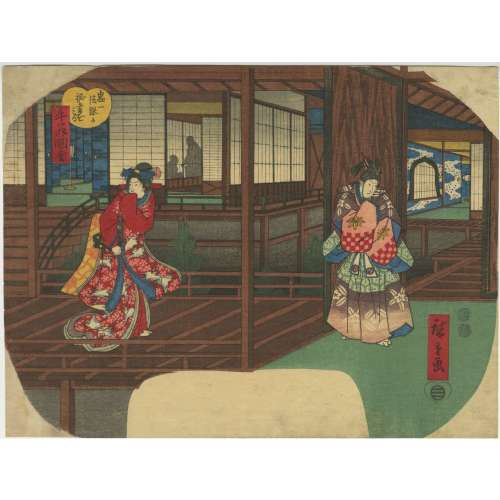 NEWTitle: The Secret Meeting between Ushiwakamaru and the Daughter of Kiichi Hōgen (Kiichi Hōgen ga hisho o miro) [鬼一法眼が秘書をみる] Series: Scenes from the life of Ushiwaka (Ushiwaka zue) [牛若図会] Artist: Utagawa Hiroshige [歌川 広重] a.k.a. Andō Hiroshige [安藤 広重] (Japanese, 1797 – 1858) Signature: Hiroshige ga [廣重画] Dimensions: Aiban yoko-e uchiwa-e, 226 x 303 mm. Censor seal: Hama & Magome [濱 / 馬込]: 1/1849 – 2/1852 (Kaei 2-5) Publisher: Ibaya Senzaburō [伊場屋仙三郎] (Japanese, fl. C. 1845 – 1847), seal: San [三] (Marks 11-001 | 127c). According to Rupert Faulkner (2001), another copy of this fan print is housed at Ōta Memorial Museum (ŌMM 1998, № 258). There are four other known prints from this series: (1) The Meeting at Yahagi: The Beginnings of the Jorurijunidan Story (Yahagi no Shuku Jorurijunidan no Hajime); (2) Ushiwakamaru practising swordsmanship at Sojogatani (ŌMM 1998, no.256); (3) Ushiwakamaru's encounter with Benkei on Gojo Bridge (Matsuki 1924, no.93); and (4) Ise no Saburo swearing an oath of loyalty to Ushiwakamaru (Kanagawa Prefectural Museum of Cultural History). Kiichi Hōgen [鬼一法眼] is a legendary monk and warrior who trained Ushiwakamaru (young Minamoto no Yoshitsune) in swordsmanship, tactics, and magic.Another print (Ushiwakamaru's encounter with Benkei on Gojo Bridge) from this series is in the collection of the Art Institute of Chicago under the title Killing One Thousand People at Gojo Bridge (Gojo no hashi sennin kiri).
NEWTitle: The Secret Meeting between Ushiwakamaru and the Daughter of Kiichi Hōgen (Kiichi Hōgen ga hisho o miro) [鬼一法眼が秘書をみる] Series: Scenes from the life of Ushiwaka (Ushiwaka zue) [牛若図会] Artist: Utagawa Hiroshige [歌川 広重] a.k.a. Andō Hiroshige [安藤 広重] (Japanese, 1797 – 1858) Signature: Hiroshige ga [廣重画] Dimensions: Aiban yoko-e uchiwa-e, 226 x 303 mm. Censor seal: Hama & Magome [濱 / 馬込]: 1/1849 – 2/1852 (Kaei 2-5) Publisher: Ibaya Senzaburō [伊場屋仙三郎] (Japanese, fl. C. 1845 – 1847), seal: San [三] (Marks 11-001 | 127c). According to Rupert Faulkner (2001), another copy of this fan print is housed at Ōta Memorial Museum (ŌMM 1998, № 258). There are four other known prints from this series: (1) The Meeting at Yahagi: The Beginnings of the Jorurijunidan Story (Yahagi no Shuku Jorurijunidan no Hajime); (2) Ushiwakamaru practising swordsmanship at Sojogatani (ŌMM 1998, no.256); (3) Ushiwakamaru's encounter with Benkei on Gojo Bridge (Matsuki 1924, no.93); and (4) Ise no Saburo swearing an oath of loyalty to Ushiwakamaru (Kanagawa Prefectural Museum of Cultural History). Kiichi Hōgen [鬼一法眼] is a legendary monk and warrior who trained Ushiwakamaru (young Minamoto no Yoshitsune) in swordsmanship, tactics, and magic.Another print (Ushiwakamaru's encounter with Benkei on Gojo Bridge) from this series is in the collection of the Art Institute of Chicago under the title Killing One Thousand People at Gojo Bridge (Gojo no hashi sennin kiri).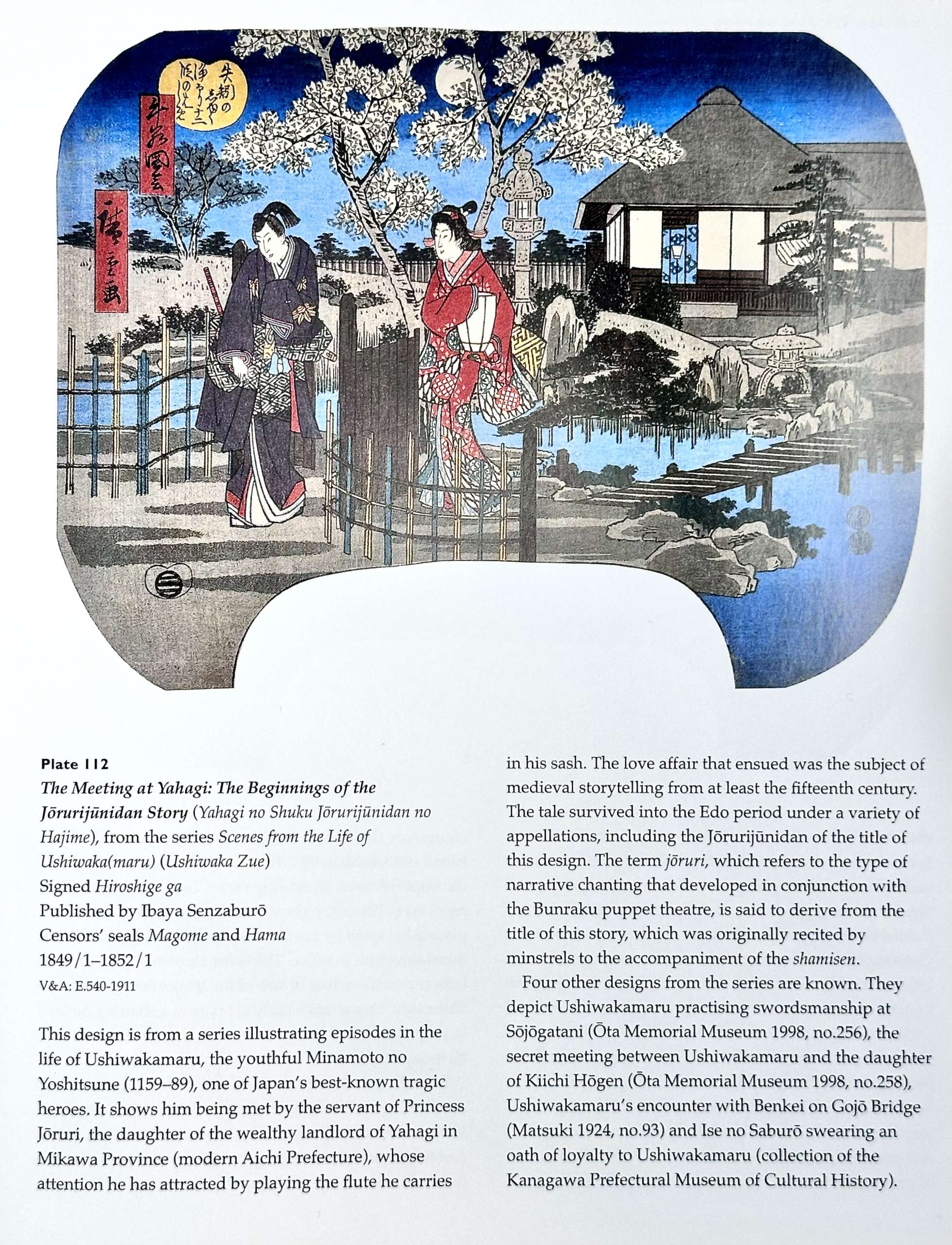
Rupert Faulkner (2001)
Reference: (1) Rupert Faulkner. Hiroshige Fan Prints / Victoria and Albert Museum, Far Eastern Series. — London: V&A Publications; NY: Harry N. Abrams, Inc., 2001. (2) Christophe Marquet. Hiroshige: Les éventails d'Edo / Estampes de la collection Georges Leskowicz. — Paris: In fine, 2022. [Thanks to Horst Graebner].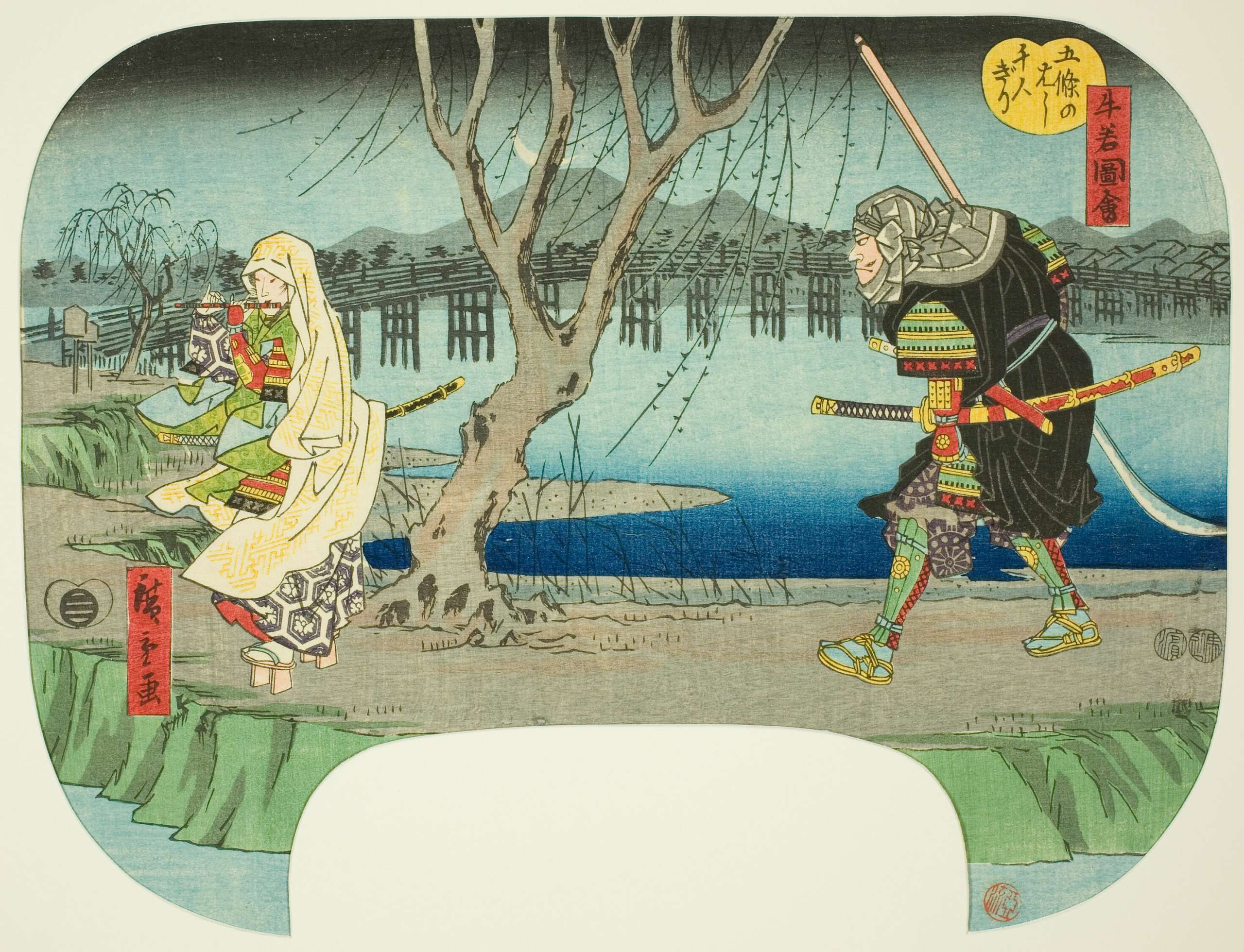
AIC Reference Number 1925.3802
-
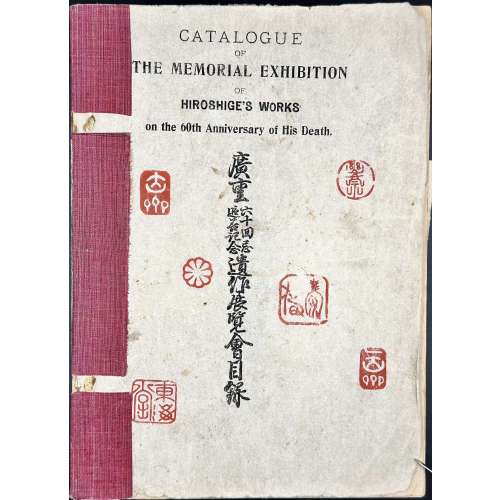 NEWPaperback volume with quarter red cloth backing 257 x 185 mm, black lettering in English and Japanese to front, red seals fac-simile to front and back; pp. [6] 1-6, 2-6 plates verso only, 7-26 [4] 1-66 [2] 7-88 plates verso only [2], some plates in colour with captioned tissue guards, incl. frontispiece memorial portrait of Utagawa Hiroshige [歌川 広重] a.k.a. Andō Hiroshige [安藤 広重] (Japanese, 1797 – 1858). Limited edition of 275 copies, this is copy № 254. Title-page: CATALOGUE | OF | THE MEMORIAL EXHIBITION | OF | HIROSHIGE'S WORKS | on the 60th Anniversary of His Death. | {red diamond} | Compiled and Published | BY | S. WATANABE. | (Ukiyoye Association) | TOKYO. | 1918. || Author: Shōzaburō Watanabe [渡辺 庄三郎] (Japanese, 1885 – 1962) Five fan prints: № 173. REFLECTED MOON ON THE SUMIDA. № 174. TOTO SHINAGAWA NO KEI. Shinagawa Beach, Yedo. № 179. ZUSÕ HAKONEYAMA YAKO NO ZU. Night Ascent of Hakone Pass. Published by Dansendo. № 180. TSUKI NO SANKEI. Beauties in a boat enjoying evening cool at Ryōgoku, from Three Moonlight Scenes. Published by Dansendo. № 182. SUMIDAGAWA HASHIBA WATASHI VUKI NO KEI. A Ferry Boat at a Sumida River Landing in Snow.
NEWPaperback volume with quarter red cloth backing 257 x 185 mm, black lettering in English and Japanese to front, red seals fac-simile to front and back; pp. [6] 1-6, 2-6 plates verso only, 7-26 [4] 1-66 [2] 7-88 plates verso only [2], some plates in colour with captioned tissue guards, incl. frontispiece memorial portrait of Utagawa Hiroshige [歌川 広重] a.k.a. Andō Hiroshige [安藤 広重] (Japanese, 1797 – 1858). Limited edition of 275 copies, this is copy № 254. Title-page: CATALOGUE | OF | THE MEMORIAL EXHIBITION | OF | HIROSHIGE'S WORKS | on the 60th Anniversary of His Death. | {red diamond} | Compiled and Published | BY | S. WATANABE. | (Ukiyoye Association) | TOKYO. | 1918. || Author: Shōzaburō Watanabe [渡辺 庄三郎] (Japanese, 1885 – 1962) Five fan prints: № 173. REFLECTED MOON ON THE SUMIDA. № 174. TOTO SHINAGAWA NO KEI. Shinagawa Beach, Yedo. № 179. ZUSÕ HAKONEYAMA YAKO NO ZU. Night Ascent of Hakone Pass. Published by Dansendo. № 180. TSUKI NO SANKEI. Beauties in a boat enjoying evening cool at Ryōgoku, from Three Moonlight Scenes. Published by Dansendo. № 182. SUMIDAGAWA HASHIBA WATASHI VUKI NO KEI. A Ferry Boat at a Sumida River Landing in Snow. -
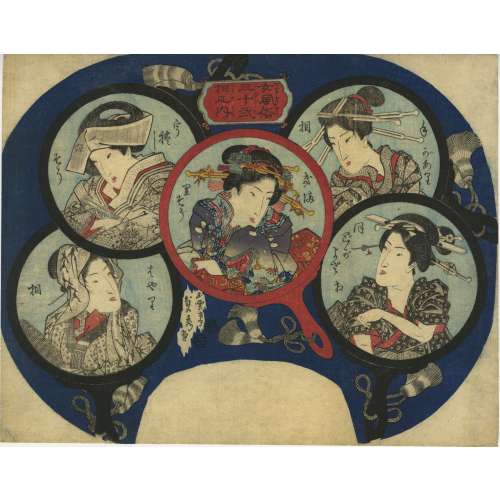 NEWArtist: Utagawa Sadahide [歌川貞秀] (Japanese, 1807 – 1879). Signed: Gountei Sadahide ga [五雲亭貞秀画] (Picture by Gountei Sadahide). Publisher: Ibaya Senzaburō [伊場屋仙三郎] (Japanese, c. 1815 – 1869); seal 三 in a circle Published: 1830s – no date seal, no censor seal (privately printed?) Media: Fan print (uchiwa-e, 団扇絵), 235 x 298 mm Inscriptions in kanji with furigana readings: Top right: "The Handy Type" (手があり相, te ga ari sō) – A composed woman adjusting her clothing. Bottom right: "Images of Manners" (風ぞくが, fūzokuga) – Possibly referring to depictions of etiquette or courtesan behaviour. The additional phrase 宵闇 (yoyami) 相 (sō) suggests a connection to nighttime activities. Centre: "The Proper Type" (きまり相, kimari sō) – A well-dressed woman seated elegantly, signifying a composed demeanour. Top left: Unclear reading (ほう☆し そう or ☆ほし そう) – Possibly related to 奉仕 (hōshi, "service" or "devotion"), implying attentiveness or subservience. Bottom left: "The Popular Type" (はやり相, hayari sō) – A fashionable woman wearing a partially veiled head covering, reflecting contemporary trends. Thanks to Horst Graebner.
NEWArtist: Utagawa Sadahide [歌川貞秀] (Japanese, 1807 – 1879). Signed: Gountei Sadahide ga [五雲亭貞秀画] (Picture by Gountei Sadahide). Publisher: Ibaya Senzaburō [伊場屋仙三郎] (Japanese, c. 1815 – 1869); seal 三 in a circle Published: 1830s – no date seal, no censor seal (privately printed?) Media: Fan print (uchiwa-e, 団扇絵), 235 x 298 mm Inscriptions in kanji with furigana readings: Top right: "The Handy Type" (手があり相, te ga ari sō) – A composed woman adjusting her clothing. Bottom right: "Images of Manners" (風ぞくが, fūzokuga) – Possibly referring to depictions of etiquette or courtesan behaviour. The additional phrase 宵闇 (yoyami) 相 (sō) suggests a connection to nighttime activities. Centre: "The Proper Type" (きまり相, kimari sō) – A well-dressed woman seated elegantly, signifying a composed demeanour. Top left: Unclear reading (ほう☆し そう or ☆ほし そう) – Possibly related to 奉仕 (hōshi, "service" or "devotion"), implying attentiveness or subservience. Bottom left: "The Popular Type" (はやり相, hayari sō) – A fashionable woman wearing a partially veiled head covering, reflecting contemporary trends. Thanks to Horst Graebner. -
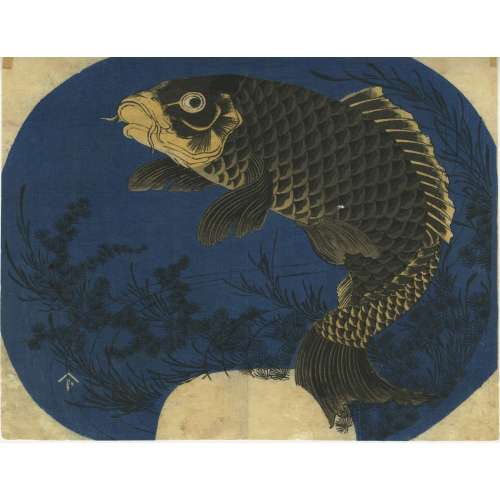 NEWAn uncut fan print depicting a carp (koi) swimming amid aquatic plants against a deep blue background. Artist: unknown/unsigned, possibly Katsushika Hokusai [葛飾 北斎] (Japanese, 1760 – 1849). Publisher: Enshūya Matabei [遠州屋又兵衛] (Japanese, fl. c. 1768 – 1881) Date: No date seal, no censor seal (privately printed?) Media: Fan print (uchiwa-e, 団扇絵), 224 x 290 mm. Similar subject:
NEWAn uncut fan print depicting a carp (koi) swimming amid aquatic plants against a deep blue background. Artist: unknown/unsigned, possibly Katsushika Hokusai [葛飾 北斎] (Japanese, 1760 – 1849). Publisher: Enshūya Matabei [遠州屋又兵衛] (Japanese, fl. c. 1768 – 1881) Date: No date seal, no censor seal (privately printed?) Media: Fan print (uchiwa-e, 団扇絵), 224 x 290 mm. Similar subject: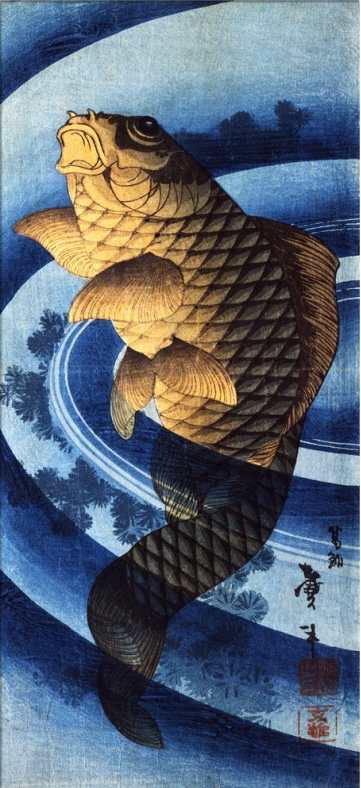
Katsushika TAITO II (fl. c. 1810-53)
-
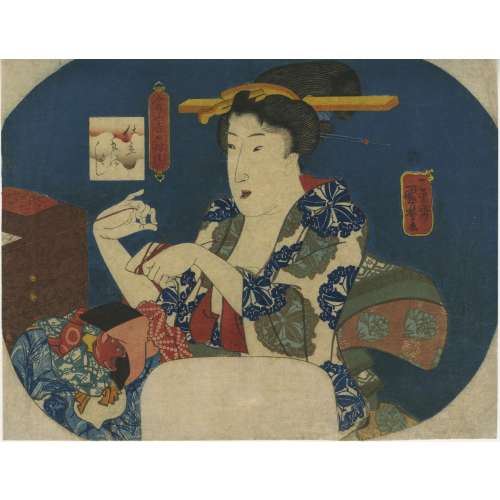 NEW
NEWA half-length portrait of a woman seated in an interior, winding red thread, dressed in a richly decorated kimono featuring intricate floral motifs in blue, green, and brown hues with a red underlayer. Her elaborately styled hair is adorned with a yellow comb and multiple hairpins. To her left is a partially visible wooden chest of drawers, to which a piece of red paper bearing calligraphy is affixed. A puppet or doll dressed in a patterned kimono with a striking red-painted face rests on her lap or a surface before her.
An uncut fan print (aiban yoko-e uchiwa-e) entitled “Good tailoring” or “Good sewing [仕立ものよし] (shitate monoyoshi)” from the series "It’s an Auspicious Day to…" [最上吉日つくし] (Saijō [no] kichijitsu tsukushi).
Artist: Utagawa Kuniyoshi [歌川 國芳] (Japanese, 1798 – 1861).
Signature: Ichiyûsai Kuniyoshi giga (一勇斎 國芳戯画, playfully drawn by Ichiyûsai Kuniyoshi).
Publisher: Enshūya Matabei [遠州屋又兵衛] (Enterprise, active c. 1768 – 1881); seal: "to" (ト) under roof (Marks 01-031 | 057a). Nanushi seal Watari (渡) for Watanabe Shōemon, VI/1842-V 1c/1846. Media: Fan print (uchiwa-e, 団扇絵), 224 x 290 mm. Reference: (1) Kuniyoshi project; (2) Tokyo Museum Digital Archive [Thanks to Horst Greabner] -
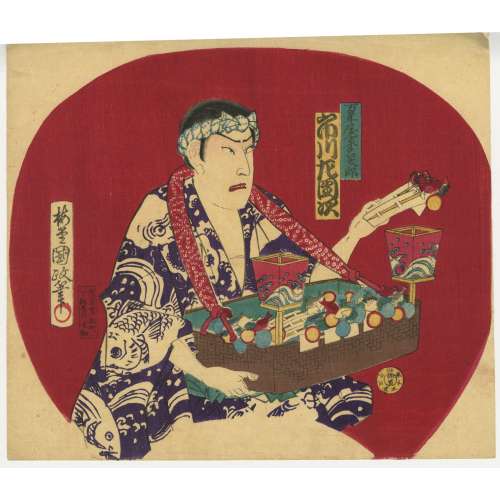 NEW
NEWTitle: Kabuki Actor Ichikawa Sadanji I as Mannenya Kamei Tarō
Artist: Utagawa Kunisada III (Baido Kunimasa) [Japanese, 1848–1920]
Signature: Baidō Kunimasa hitsu (梅堂國政筆)
Actor: Ichikawa Sadanji I (市川左団次, also known as Ichikawa Shōjaku I, Ichikawa Koyone, Ichikawa Tatsuzō) [Japanese, 1842–1904]
Role: Mannenya Kamei Tarō (万年屋家名太郎)
Play: Unidentified
Publisher: Shimōsaya Masukichi (下総屋升吉)
Publisher’s Address: Asakusa, Kurofune-chō (浅草 黒舩)
Date: [明治十三年三月] Meiji 13 (1880), 3rd month
Medium: Uchiwa-e (団扇絵, fan print), ink and colour on paper, 245 × 282 mmThis uchiwa-e (fan print) by Utagawa Kunisada III (also known as Utagawa Kunimasa IV) portrays the kabuki actor Ichikawa Sadanji I in the role of Mannenya Kamei Tarō. The figure is depicted in a dramatic stance, dressed in a striking blue kimono adorned with fish and wave motifs, suggesting a maritime or festival connection. He carries a large basket supported by a fabric strap around his neck, filled with small toy fish attached to sticks, along with round objects that could be festival sweets or miniature decorations. He holds one of these toy fish-on-a-stick items in his right hand, possibly demonstrating it as part of a vendor's performance.
The background is a bold, deep red, contrasting with the detailed rendering of the actor’s expression and costume. The print was published in 1897 (Meiji 30) by Shimōsaya Masukichi, a publisher based in Asakusa, Kurofune-chō. Though the exact play remains unidentified, the composition captures a moment from a kabuki performance where street vendors and festival sellers were often featured as comic or supporting characters in Edo-period narratives.
This work exemplifies the continuation of traditional kabuki actor portraiture into the Meiji period, reflecting both theatrical culture and popular printmaking traditions at the time.
-
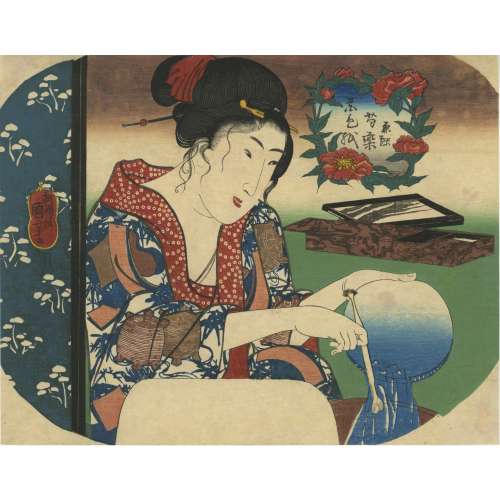 NEWPeonies (Shakuyaku) [芍薬] Series: Flower-Colored Papers (Hana Shikishi) [花色紙] Artist: Utagawa Kuniyoshi [歌川 國芳] (Japanese, 1798–1861) Signature: Chō-ō-rō Kuniyoshi ga (朝櫻楼 國芳 画) Publisher: Kojimaya Jūbei [小島屋 十兵衛] (Japanese, 1797 – 1869); seal 十, Marks 06-014 | 264a Date/Censorship Approval: Nanushi seal Yoshimura (吉村) for Yoshimura Gentarō (吉村 源太郎), VI/1843–XI/1846. Medium: Rigid fan print (Aiban Yoko-e Uchiwa-e, 合判横絵 団扇絵), 222 x 284 mm.
NEWPeonies (Shakuyaku) [芍薬] Series: Flower-Colored Papers (Hana Shikishi) [花色紙] Artist: Utagawa Kuniyoshi [歌川 國芳] (Japanese, 1798–1861) Signature: Chō-ō-rō Kuniyoshi ga (朝櫻楼 國芳 画) Publisher: Kojimaya Jūbei [小島屋 十兵衛] (Japanese, 1797 – 1869); seal 十, Marks 06-014 | 264a Date/Censorship Approval: Nanushi seal Yoshimura (吉村) for Yoshimura Gentarō (吉村 源太郎), VI/1843–XI/1846. Medium: Rigid fan print (Aiban Yoko-e Uchiwa-e, 合判横絵 団扇絵), 222 x 284 mm.Interpretation of the Inscription in the Floral Cartouche
- 花色紙 (Hana Shikishi) – "Flower-Colored Paper" or "Decorative Shikishi Paper with Floral Motifs"
- 芍薬 (Shakuyaku) – "Peony", a flower symbolizing prosperity, beauty, and romance in Japanese culture
- 団扇絵 (Uchiwa-e) – "Round Fan Illustration" or "Picture on an Uchiwa (rigid fan)"
Description & Symbolic Analysis
This print, part of the Hana Shikishi (Flower-Colored Papers) series, depicts a woman washing a basin after brushing her teeth. She is positioned behind an indigo-colored folding screen, adorned with a repeating pattern of distant pines, presented in reverse printing technique (wyabori, 捺ぼり). The screen is a visual separator, adding depth and an intimate atmosphere to the scene. The woman is portrayed in a three-quarter view, facing left, her face delicately contoured. She is dressed in a safflower-dyed kimono (furisode, 振袖) featuring an asanoha (麻の葉, hemp leaf) shibori pattern, a motif often associated with purity and protection. Over this, she wears an outer garment decorated with an indigo bamboo motif, symbolizing strength and resilience. Additionally, the garment features:- Double gourd (瓢箪, hyōtan) symbolises longevity, fertility, and good fortune.
- Strips of paper resembling “next-morning letters” (kinuginu no fumi, 衣衣の文) – These evoke romantic correspondence or the written wishes of the Tanabata festival.
- Spools or reels of thread (chikiri, 糸巻き) – A motif reminiscent of Tanabata festival themes, often linked to the celestial lovers Orihime and Hikoboshi. The phonetic pun with chigiri (契り, vow or romantic promise) reinforces themes of marriage, fate, and lifelong bonds.
Adornment & Hairstyling
Her elaborate hairstyle features a red hair tie (musubi, 結び), signifying youth and romantic allure. It is further adorned with:- Golden kogai (笄) – A decorative hairpin, often used by courtesans or high-ranking women.
- Tama kanzashi (玉簪) – A ball-tipped ornamental hairpin, reinforcing her refined status.
Objects in the Scene & Their Symbolism
The woman is holding a traditional Japanese toothbrush (fusa-yōji, ふさ楊枝) in her right hand, while pouring out water from the basin after brushing her teeth. This act symbolizes purity and preparation for intimacy. To her right, an ornate lacquered writing box (suzuribako, 硯箱) is placed near an inkstone (硯, suzuri). This object could also be interpreted as a dreamstone (梦石, mèng shí), a scholar’s object associated with nostalgia, love, or secret communication.Context in Ukiyo-e Tradition
Tooth brushing was uncommon in bijin-ga (美人画, "beautiful woman prints"). Ukiyo-e frequently depicted women engaging in personal grooming rituals, reflecting ideals of elegance and self-care in Edo-period culture.
Two additional fan prints from the Hana Shikishi series have been identified and can be found at the Kuniyoshi Project website:- Morning Glory (Asagao, 朝顔)
- Clematis (Tessen, 鉄線)
These prints, like Peonies (Shakuyaku), emphasize seasonal beauty and feminine refinement, themes central to Kuniyoshi’s bijin-ga oeuvre.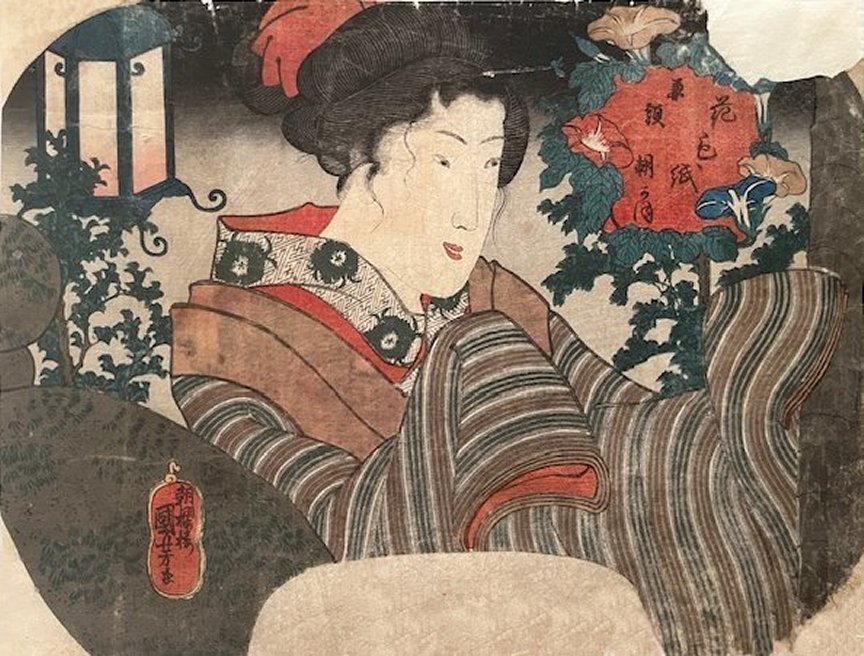
Morning Glory (Asagao, 朝顔)
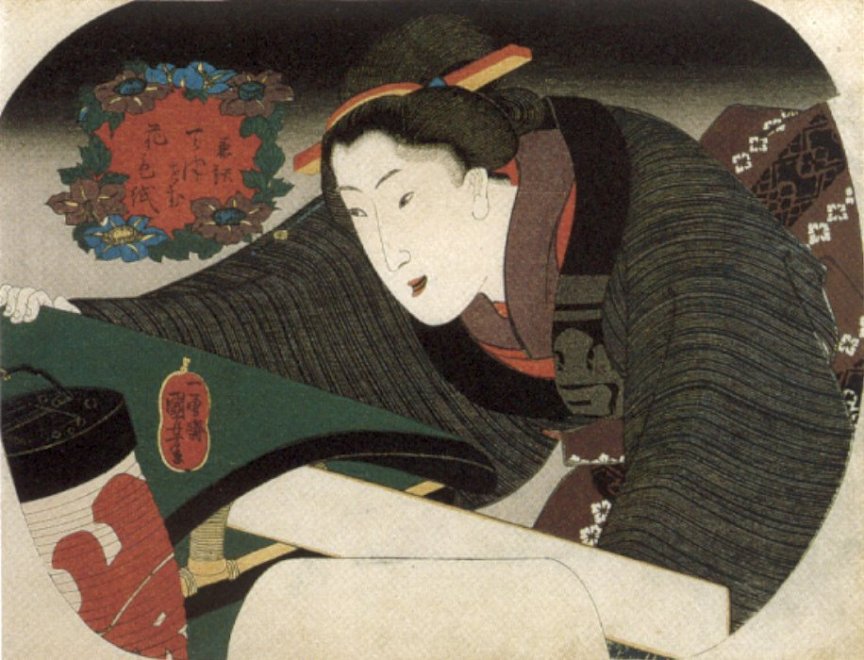
Clematis (Tessen, 鉄線)
-
 NEWArtist: Utagawa Kuniyoshi (歌川国芳) (1797–1861) Signed: 一勇斎 (Ichiyūsai) in a yellow cartouche, 國芳画 (Kuniyoshi ga) in a red cartouche Publisher: 未詳 (Yama-Ta), seal [板元, 太] – Hanmoto, Ta; Marks 19-044 | U421b Censor Seal: Aratame + Ansei 3 (3rd lunar month, 1856) Block Carver: 彫竹 (Hori Take), identified as Yokokawa Takejirō (横川竹二郎) (fl. 1845–1863) Media: Rigid fan print (Aiban Yoko-e Uchiwa-e, 合判横絵 団扇絵), 227 × 286 mm Half-length portrait of a high-ranking courtesan (oiran, 花魁) seated in a three-quarter view, holding a porcelain sake cup decorated with a blue mon of stylized oak leaves (kashiwa, 柏). She gazes downward at a partially unrolled letter resting on her lap. Her elaborate hairstyle, adorned with multiple kogai (ornamental hairpins) featuring golden floral motifs, signifies her elevated status within her profession. Her layered kimono displays a combination of red, blue, and black geometric patterns, emphasizing the luxurious textiles associated with courtesans of her rank. The stylized oak leaves on the sake cup may allude to the family mon of Onoe family of kabuki actors, evoking the overlap between theatre and the pleasure quarters. The background portrays a night scene in the Yoshiwara Pleasure District (吉原), where figures move beneath lantern-lit buildings, showing the vibrant nightlife of Edo.
NEWArtist: Utagawa Kuniyoshi (歌川国芳) (1797–1861) Signed: 一勇斎 (Ichiyūsai) in a yellow cartouche, 國芳画 (Kuniyoshi ga) in a red cartouche Publisher: 未詳 (Yama-Ta), seal [板元, 太] – Hanmoto, Ta; Marks 19-044 | U421b Censor Seal: Aratame + Ansei 3 (3rd lunar month, 1856) Block Carver: 彫竹 (Hori Take), identified as Yokokawa Takejirō (横川竹二郎) (fl. 1845–1863) Media: Rigid fan print (Aiban Yoko-e Uchiwa-e, 合判横絵 団扇絵), 227 × 286 mm Half-length portrait of a high-ranking courtesan (oiran, 花魁) seated in a three-quarter view, holding a porcelain sake cup decorated with a blue mon of stylized oak leaves (kashiwa, 柏). She gazes downward at a partially unrolled letter resting on her lap. Her elaborate hairstyle, adorned with multiple kogai (ornamental hairpins) featuring golden floral motifs, signifies her elevated status within her profession. Her layered kimono displays a combination of red, blue, and black geometric patterns, emphasizing the luxurious textiles associated with courtesans of her rank. The stylized oak leaves on the sake cup may allude to the family mon of Onoe family of kabuki actors, evoking the overlap between theatre and the pleasure quarters. The background portrays a night scene in the Yoshiwara Pleasure District (吉原), where figures move beneath lantern-lit buildings, showing the vibrant nightlife of Edo. -
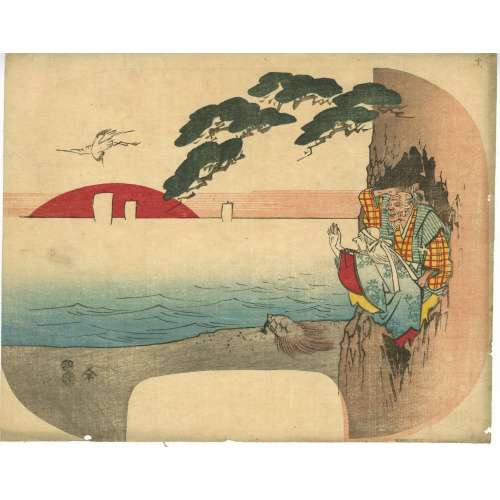 NEWArtist: Attributed to Katsushika Hokusai (葛飾 北斎) (1760–1849) – unsigned. Publisher: Unknown, seal Hei (平); Marks 05-004 | U377a (1848) Censor Seal: Double nanushi Hama (濱) & Kunigasa (衣笠) Date: Kōka 4–5 / Kaei 1 (1847–1848) Media: Rigid fan print (Aiban Yoko-e Uchiwa-e, 合判横絵 団扇絵), 239 × 301 mm The legendary elderly couple Jō and Uba (尉と姥), spirits of the paired pines of Takasago (高砂) and Sumiyoshi (住吉), are known as the Aioi-no-Matsu (相生の松). They symbolize marital harmony, longevity, and the enduring bond of love. The Takasago legend is one of the oldest in Japanese mythology, famously portrayed in the Noh play Takasago no Uta (高砂の歌).
NEWArtist: Attributed to Katsushika Hokusai (葛飾 北斎) (1760–1849) – unsigned. Publisher: Unknown, seal Hei (平); Marks 05-004 | U377a (1848) Censor Seal: Double nanushi Hama (濱) & Kunigasa (衣笠) Date: Kōka 4–5 / Kaei 1 (1847–1848) Media: Rigid fan print (Aiban Yoko-e Uchiwa-e, 合判横絵 団扇絵), 239 × 301 mm The legendary elderly couple Jō and Uba (尉と姥), spirits of the paired pines of Takasago (高砂) and Sumiyoshi (住吉), are known as the Aioi-no-Matsu (相生の松). They symbolize marital harmony, longevity, and the enduring bond of love. The Takasago legend is one of the oldest in Japanese mythology, famously portrayed in the Noh play Takasago no Uta (高砂の歌).Aioi-no-Matsu – The Paired Pines of Takasago and Sumiyoshi
The Aioi-no-Matsu refers to two pine trees growing separately but intertwined at the roots, representing an unbreakable union.- The Takasago pine (高砂の松) grows in Harima Province, while the Sumiyoshi pine (住吉の松) stands in Settsu Province.
- Though physically distant, these trees are spiritually connected, like Jō and Uba, the aged couple who embody their spirits.
- The phrase "The wind that blows through Takasago reaches Sumiyoshi" symbolizes the continuity of love and harmony across time and space.
Aioi-no-Matsu in the Noh Play Takasago
The Noh play Takasago, attributed to Zeami, popularized this imagery.- Jō and Uba appear as an elderly couple raking pine needles, revealing themselves as the spirits of the Aioi-no-Matsu.
- The play conveys the theme of eternal harmony between husband and wife, making Aioi-no-Matsu a symbol of auspicious blessings for weddings and longevity celebrations.
Symbolism in the Print
This print incorporates traditional symbols of longevity and prosperity:- A minogame (蓑亀, "straw-cloaked turtle"), representing immortality, rests near the shore.
- A crane (鶴, tsuru), a symbol of marital fidelity.
- The rising sun over the ocean represents renewal and hope for the coming year.
- Jō and Uba’s presence under the Aioi-no-Matsu (Paired Pines) evokes the traditional New Year’s wish for long life and unity.
- The minogame and crane further reinforce New Year’s themes of prosperity and fortune.
Comparison to MFA Boston Prints
This print shares strong visual and thematic connections with two works attributed to Hokusai in the MFA Boston collection:- Accession No. 21.10269 – "Jō and Uba, the Spirits of the Pine Trees of Takasago and Sumiyoshi"
- Depicts the couple sweeping pine needles, reinforcing themes of domestic harmony and renewal.
- Includes a minogame and a flying crane, similar to this print.
- Accession No. 21.7869 – Another version of "Jō and Uba"
- Shows Jō and Uba standing, gazing at the sea, in a more expansive composition.
- Features a large pine tree, crashing waves, and a red sun, mirroring the background elements in this print.
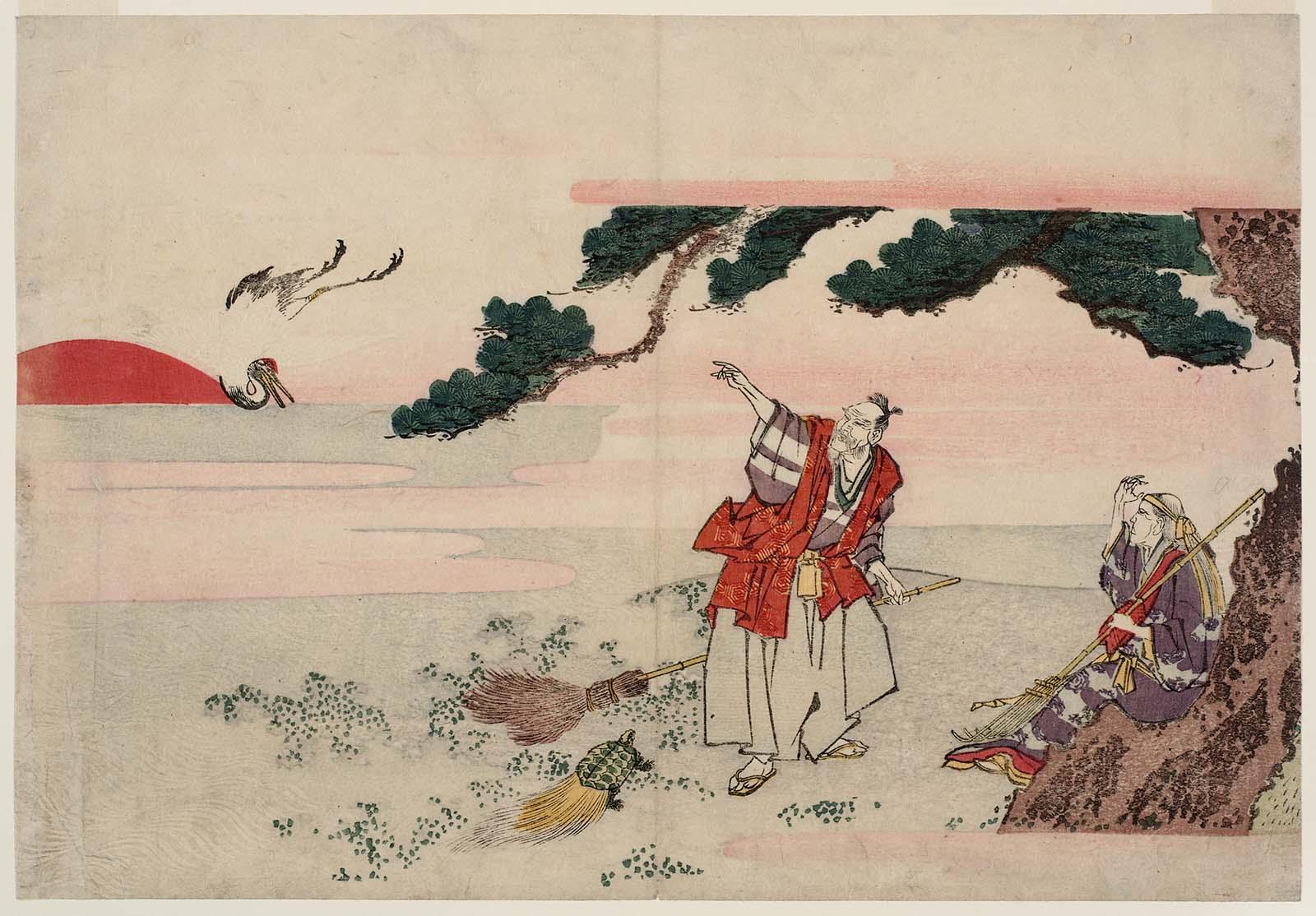
MFA-B № 21.10269
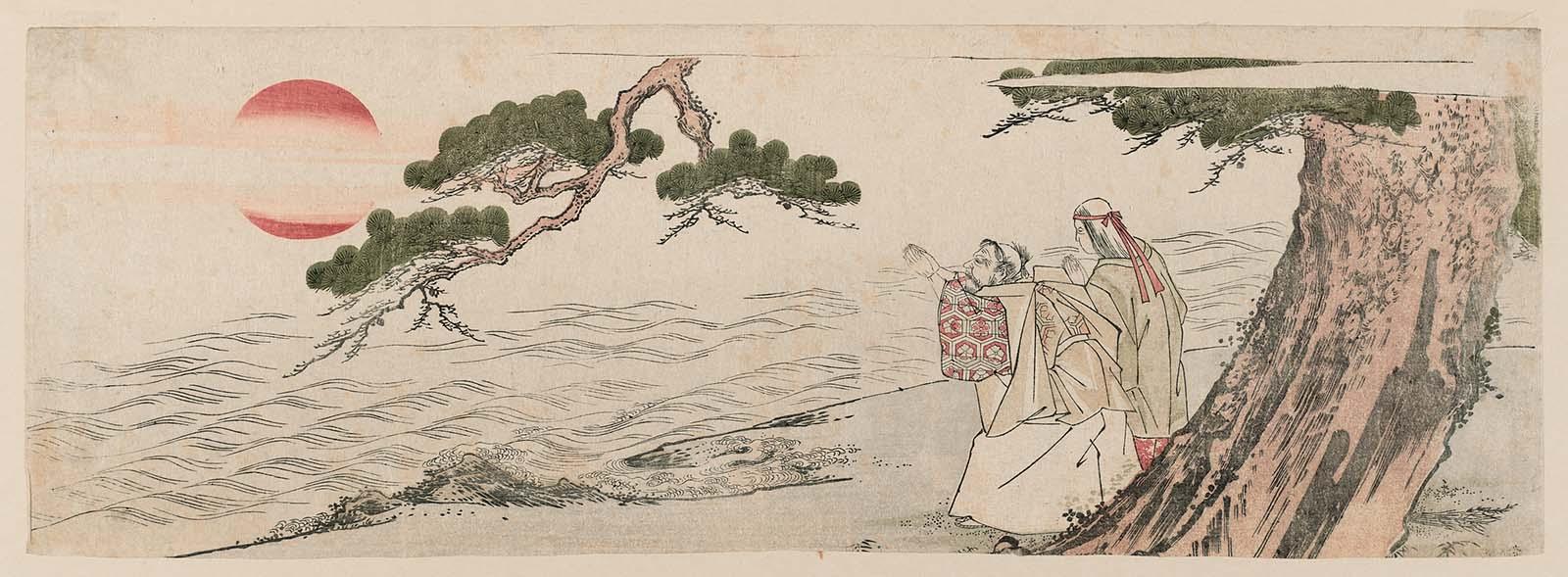
MFA-B № 21.7869
-
 NEWArtist: Utagawa Kuniyoshi (歌川国芳) (1797–1861) Signed: Ichiyūsai Kuniyoshi ga [一勇斎 國芳画] in red cartouche Date: VI/1842 – V ic/1846, single nanushi censor seal Murata (村) for censor Murata Sahei [村田佐兵衛]. Publisher: Unknown, Izuzen (Bei, 米); Marks 06-028 | U103a Media: Rigid fan print (Aiban Yoko-e Uchiwa-e, 合判横絵 団扇絵), 224 x 290 mm
NEWArtist: Utagawa Kuniyoshi (歌川国芳) (1797–1861) Signed: Ichiyūsai Kuniyoshi ga [一勇斎 國芳画] in red cartouche Date: VI/1842 – V ic/1846, single nanushi censor seal Murata (村) for censor Murata Sahei [村田佐兵衛]. Publisher: Unknown, Izuzen (Bei, 米); Marks 06-028 | U103a Media: Rigid fan print (Aiban Yoko-e Uchiwa-e, 合判横絵 団扇絵), 224 x 290 mmHalf-length portrait of a woman facing slightly to the right. She wears a patterned kimono with multiple floral and seasonal motifs, including uchiwa (round fans), plum blossoms, maple leaves, chrysanthemums, snow-covered bamboo, pine branches, and peonies. Her obi is tied in front, and a red collar is visible beneath the layers. Her hair is arranged in an elaborate updo and is adorned with a hairpin featuring a rabbit and a crescent moon, referencing lunar symbolism. She dedicates a hand towel at a washing trough (手水舎, temizuya) in a shrine. Inscriptions on the towels.
In the background, several towels are hanging, featuring various mon (family crests) and symbols:
- Three oak leaves
- Crossed or intersecting hawk feathers
- Kiri-mon (Paulownia crest, associated with Kuniyoshi)
- Toshidama (seal of the Utagawa school)
- Masu (枡, measuring box) motif – a square with diagonal lines
- Kuniyoshi Project
- [LIB-3428.2025] Christie’s, New York: Japanese Prints, Paintings, and Screens, Monday, 24 November 1997 / Sales Catalogue, № 130, p. 63.



